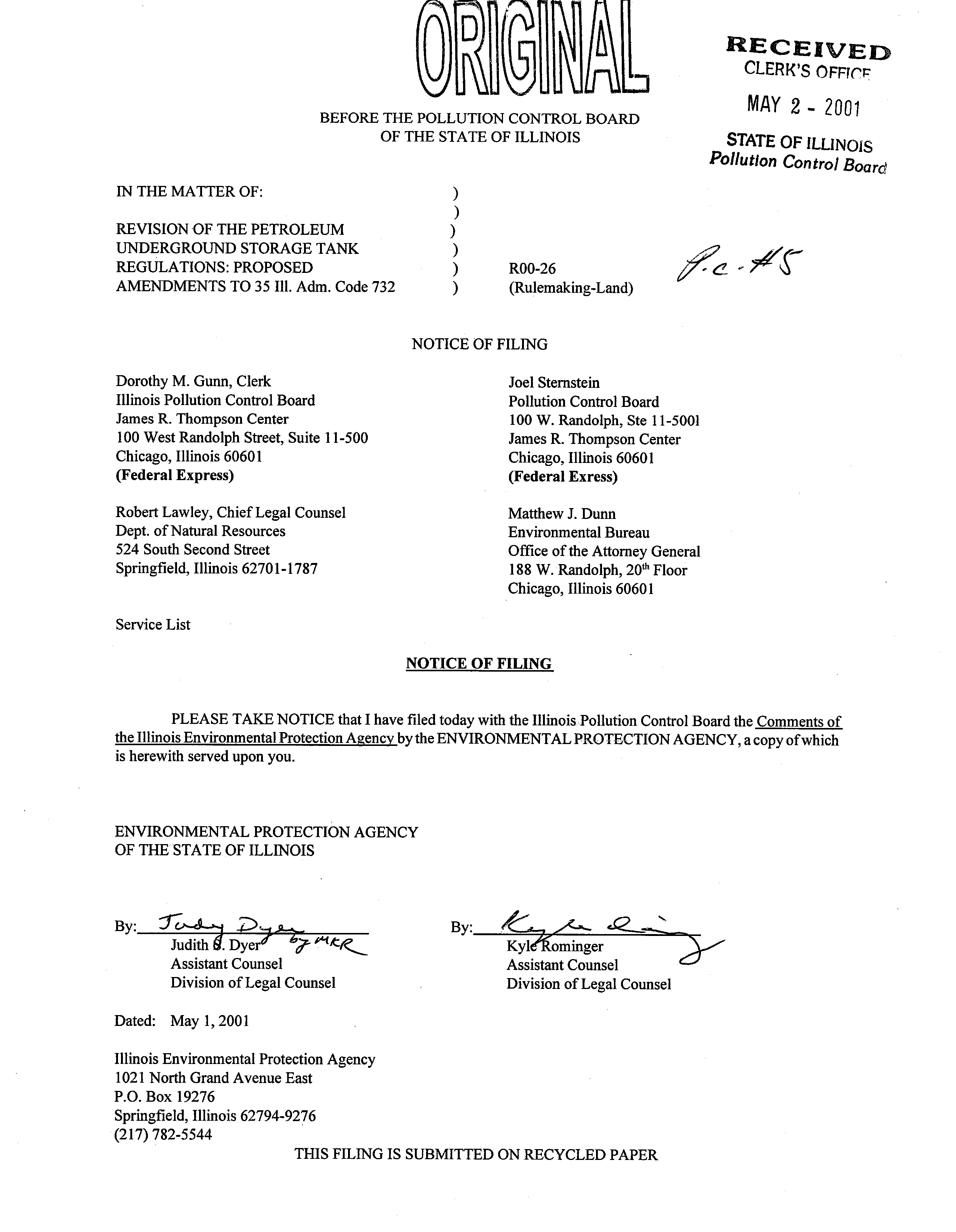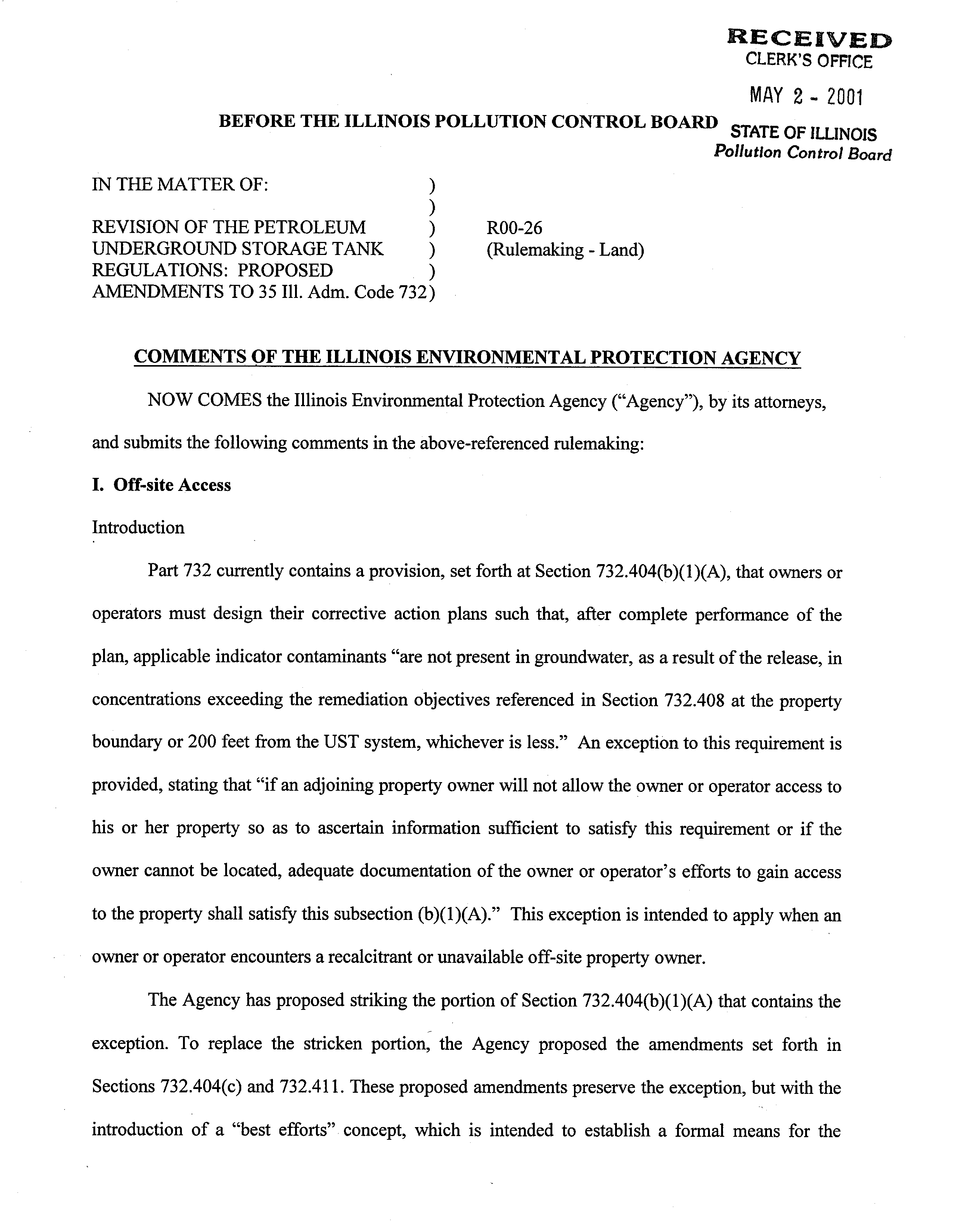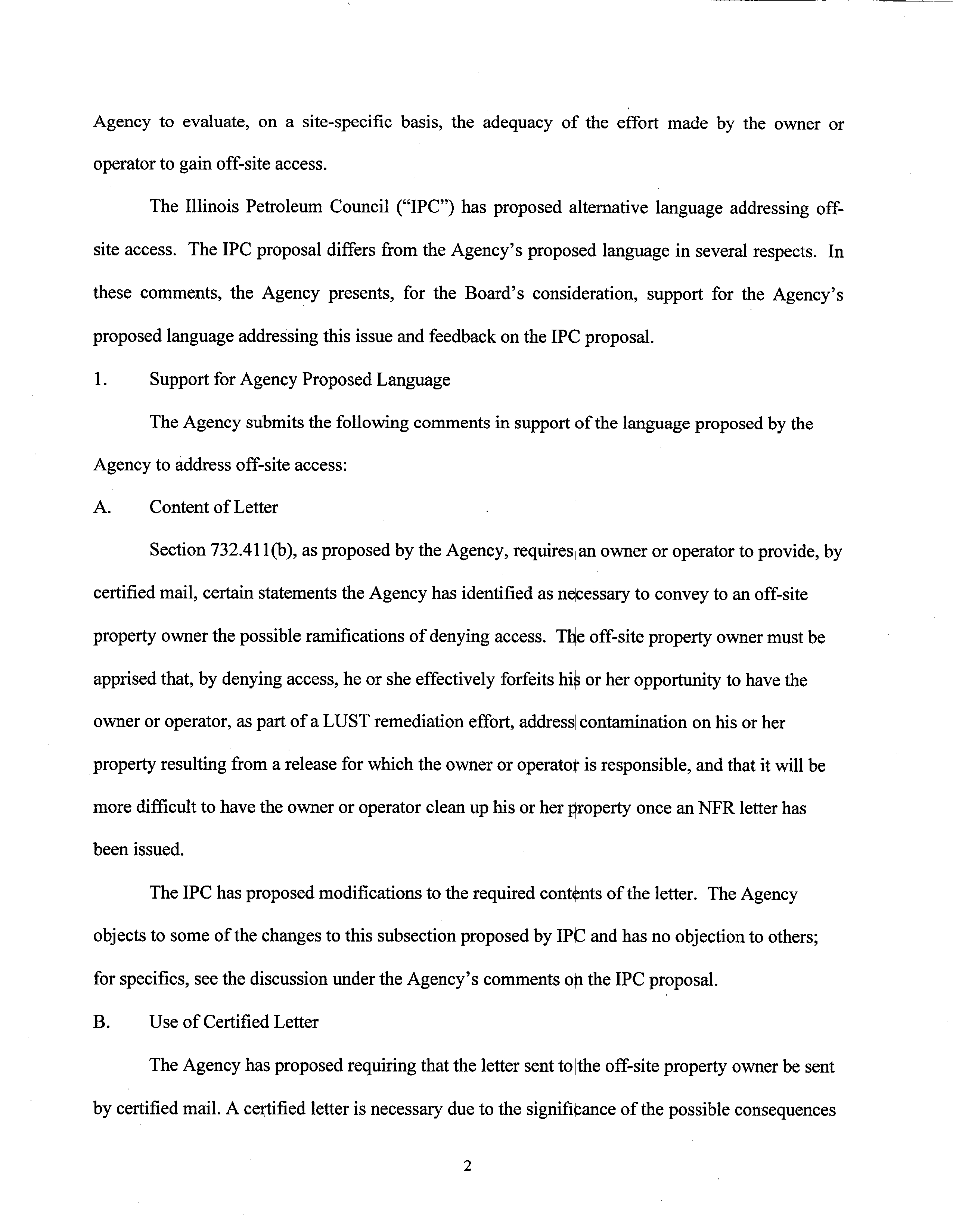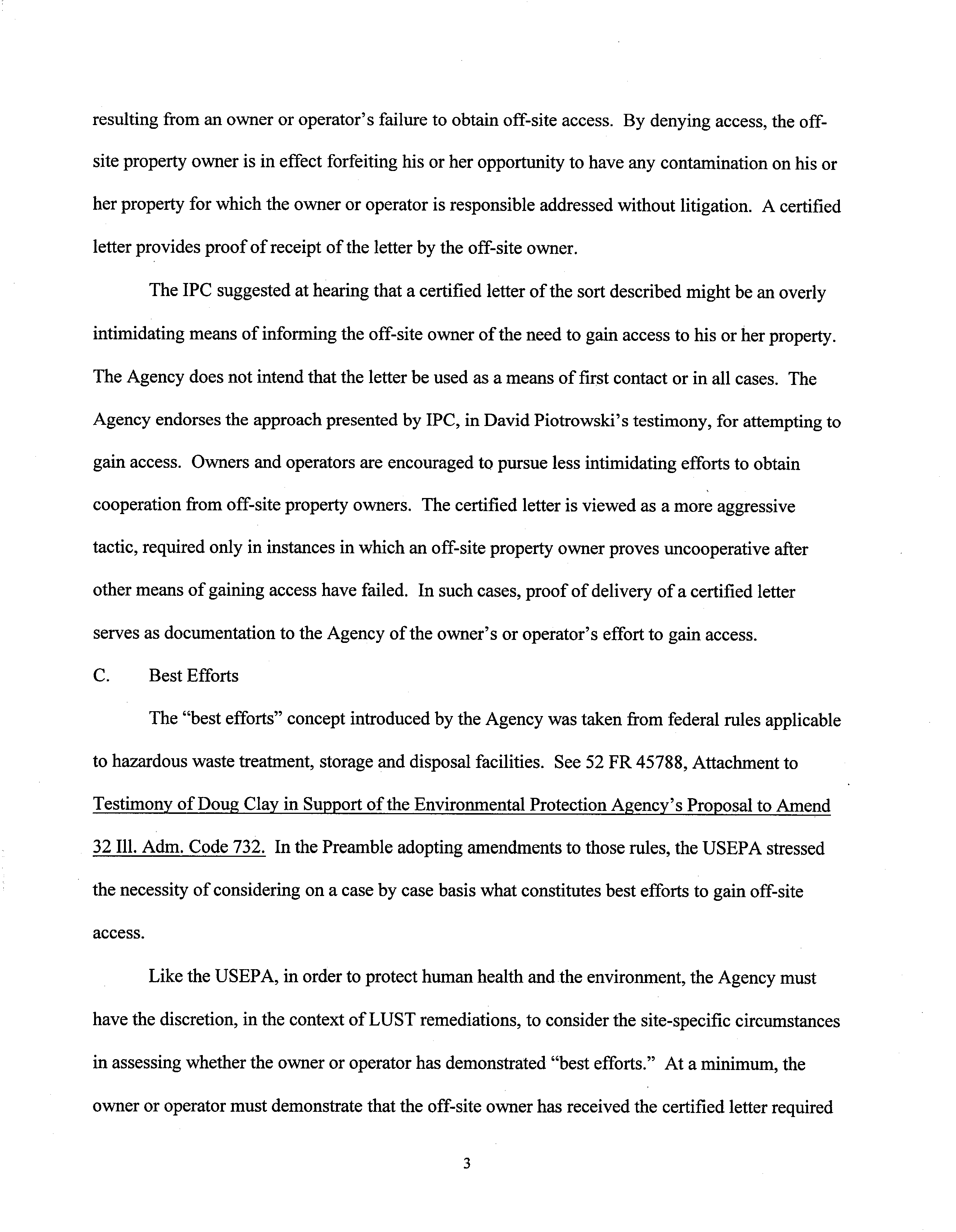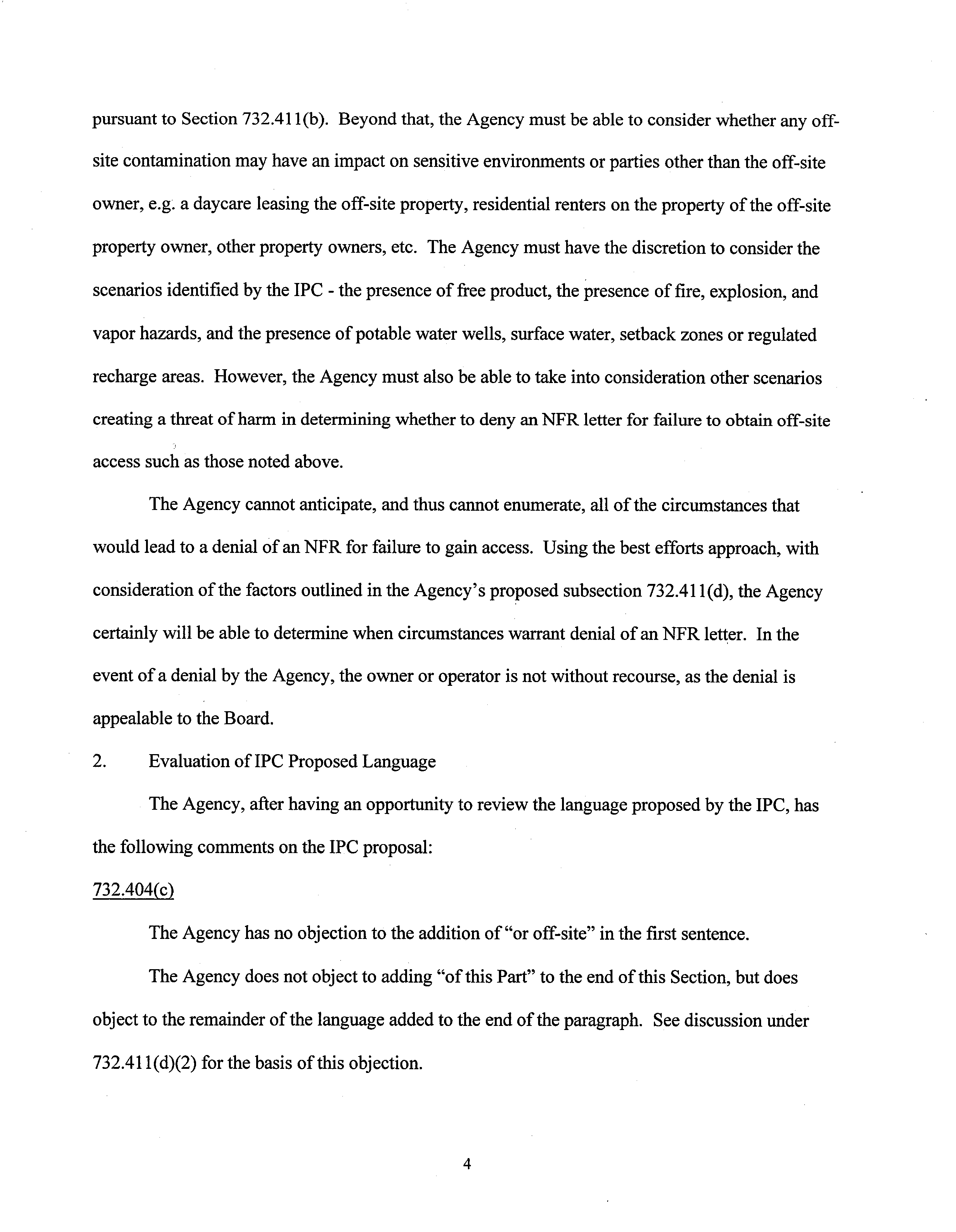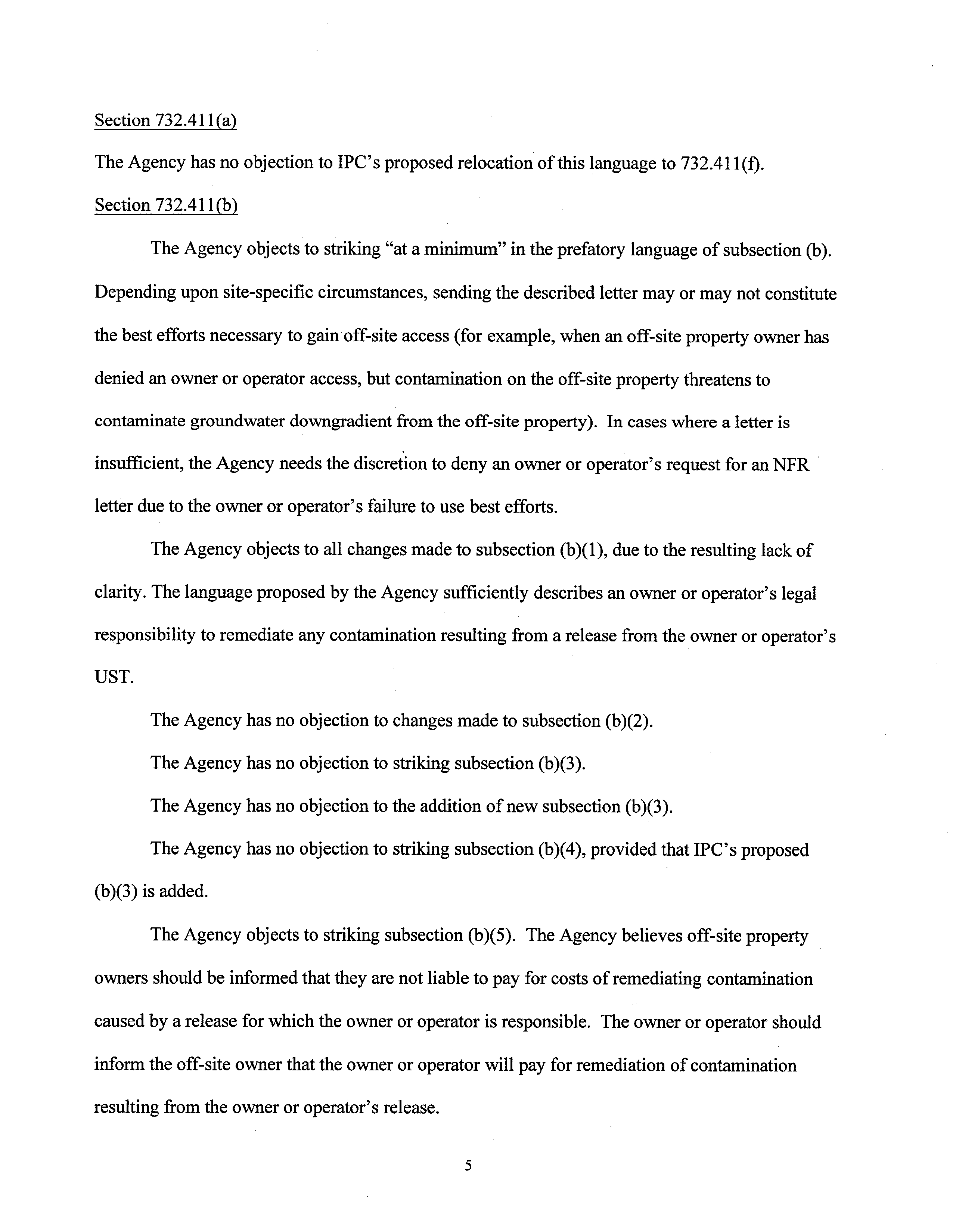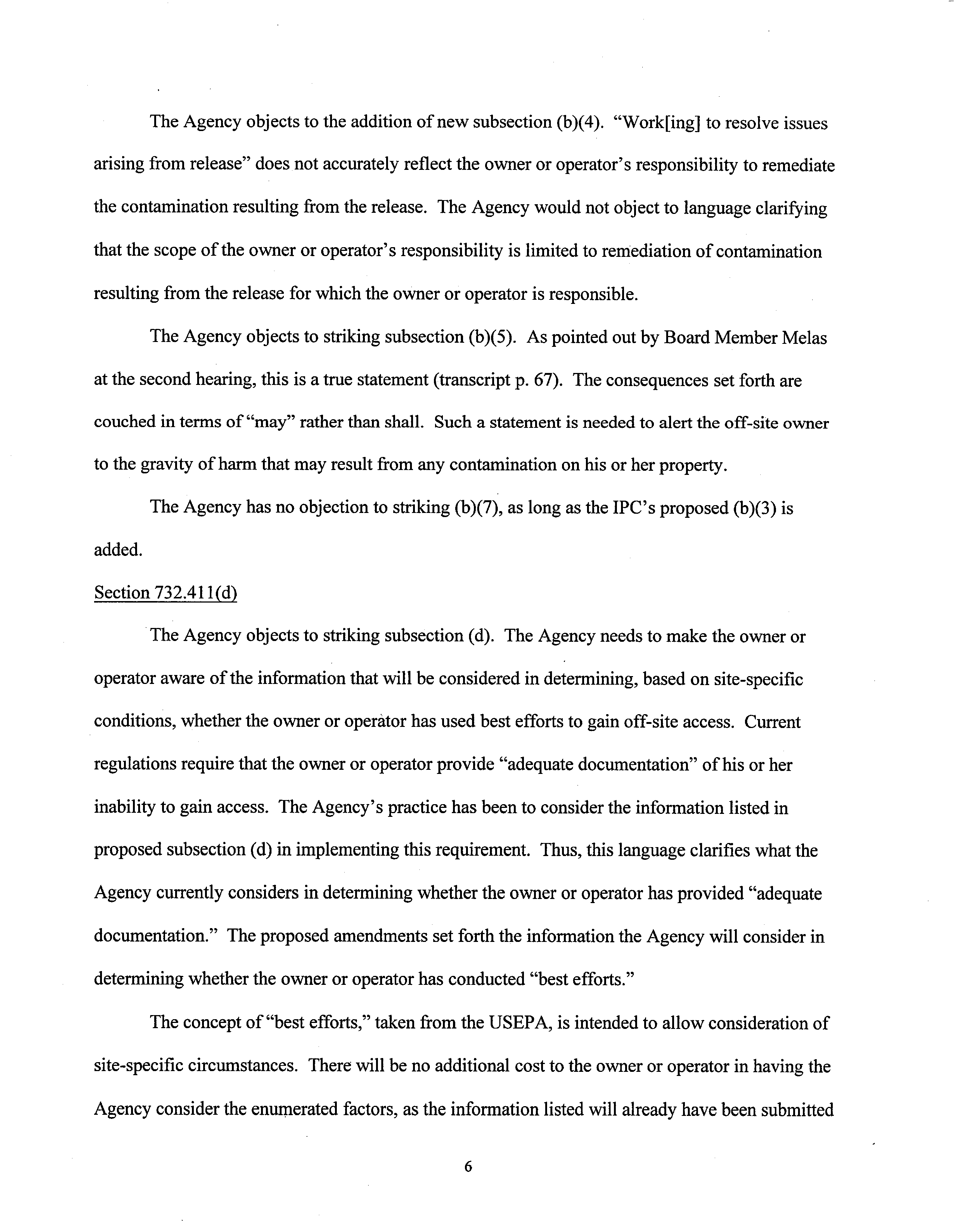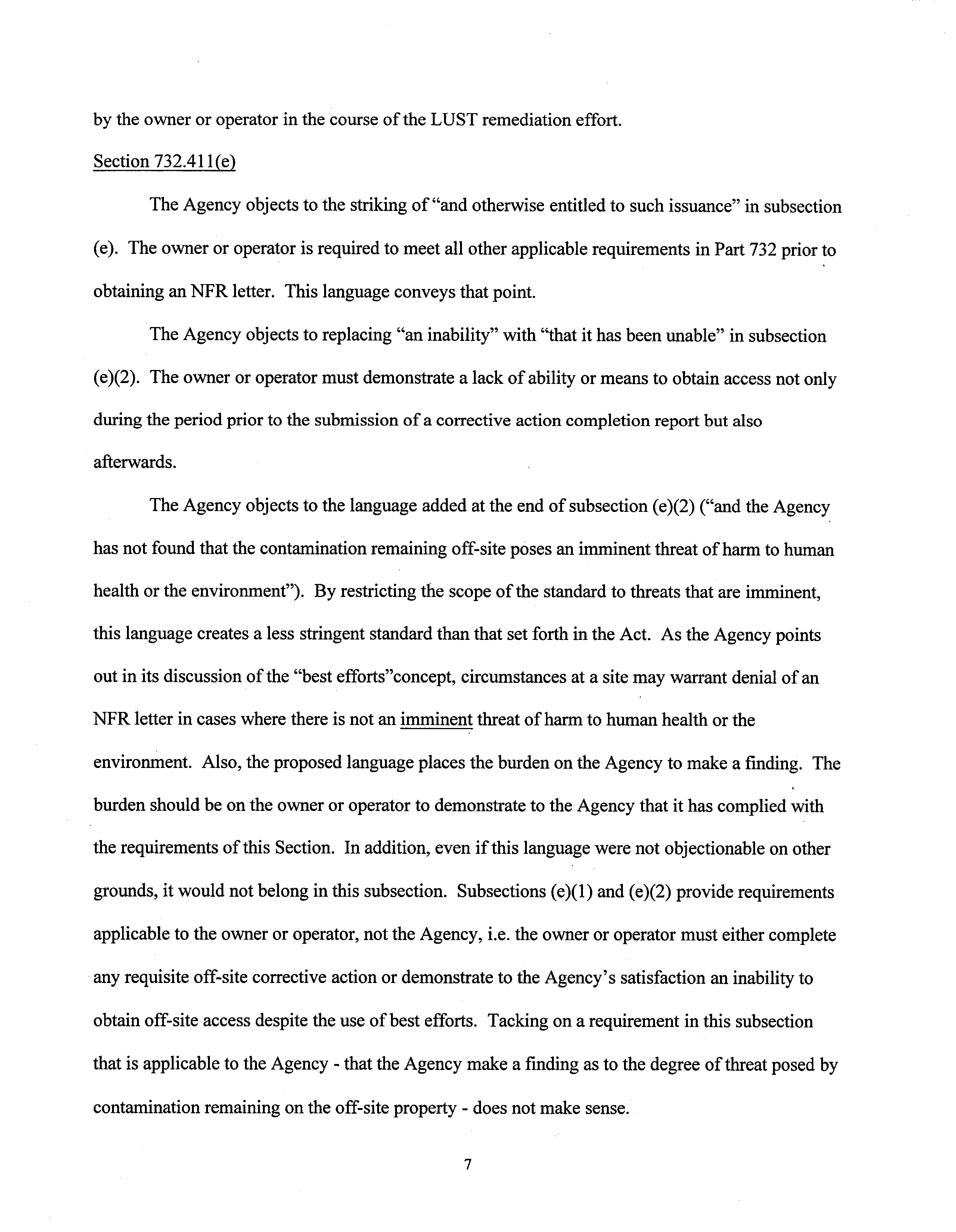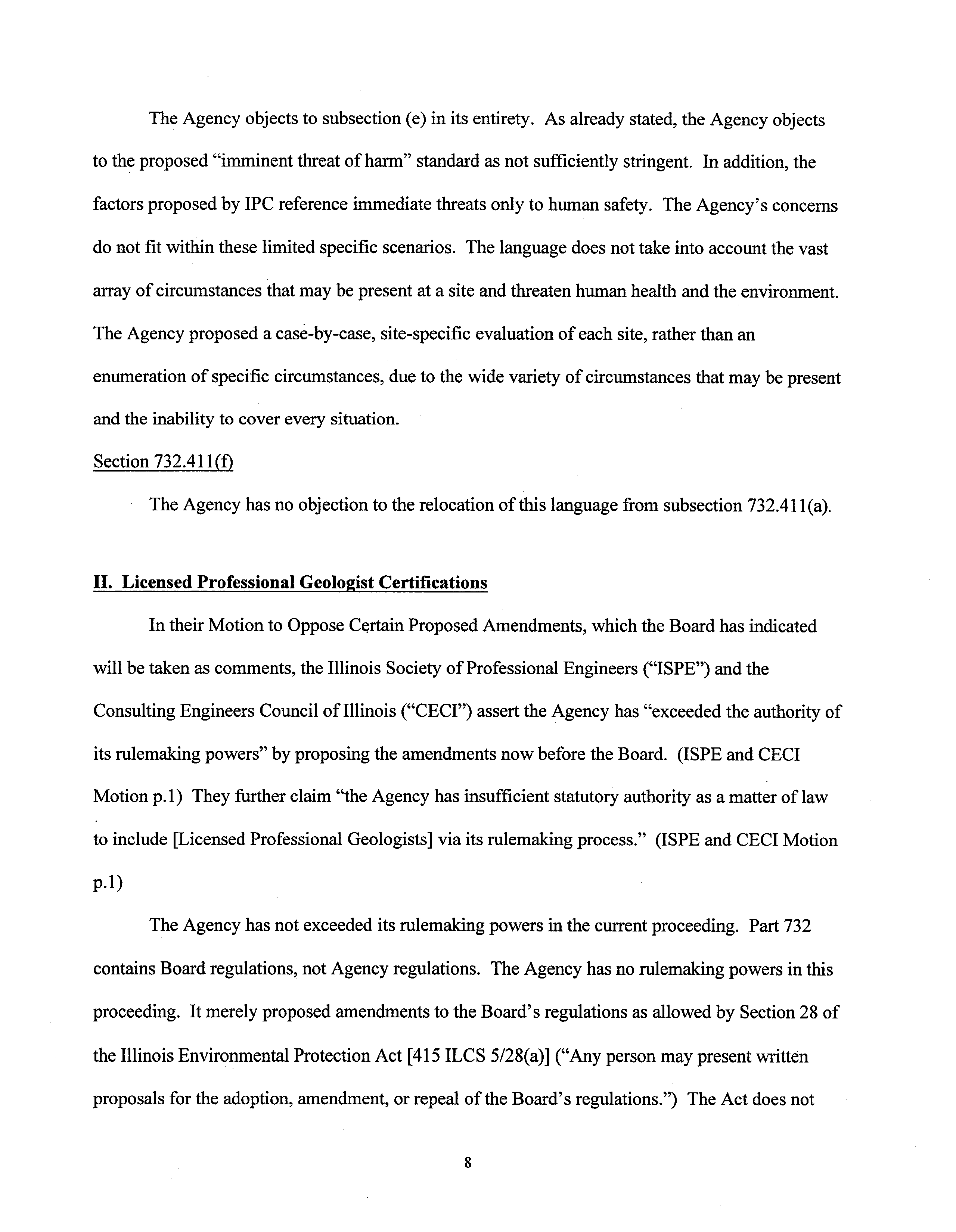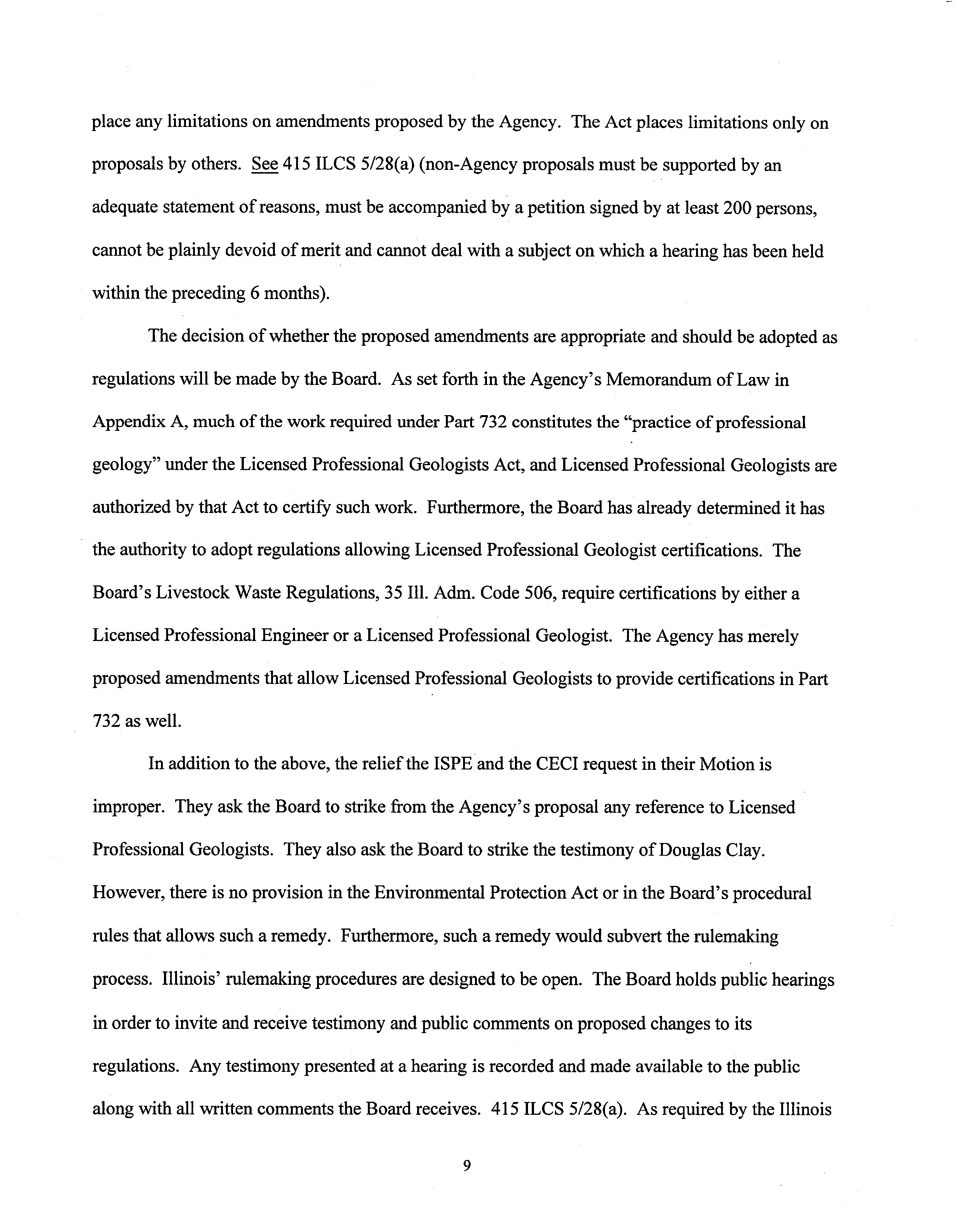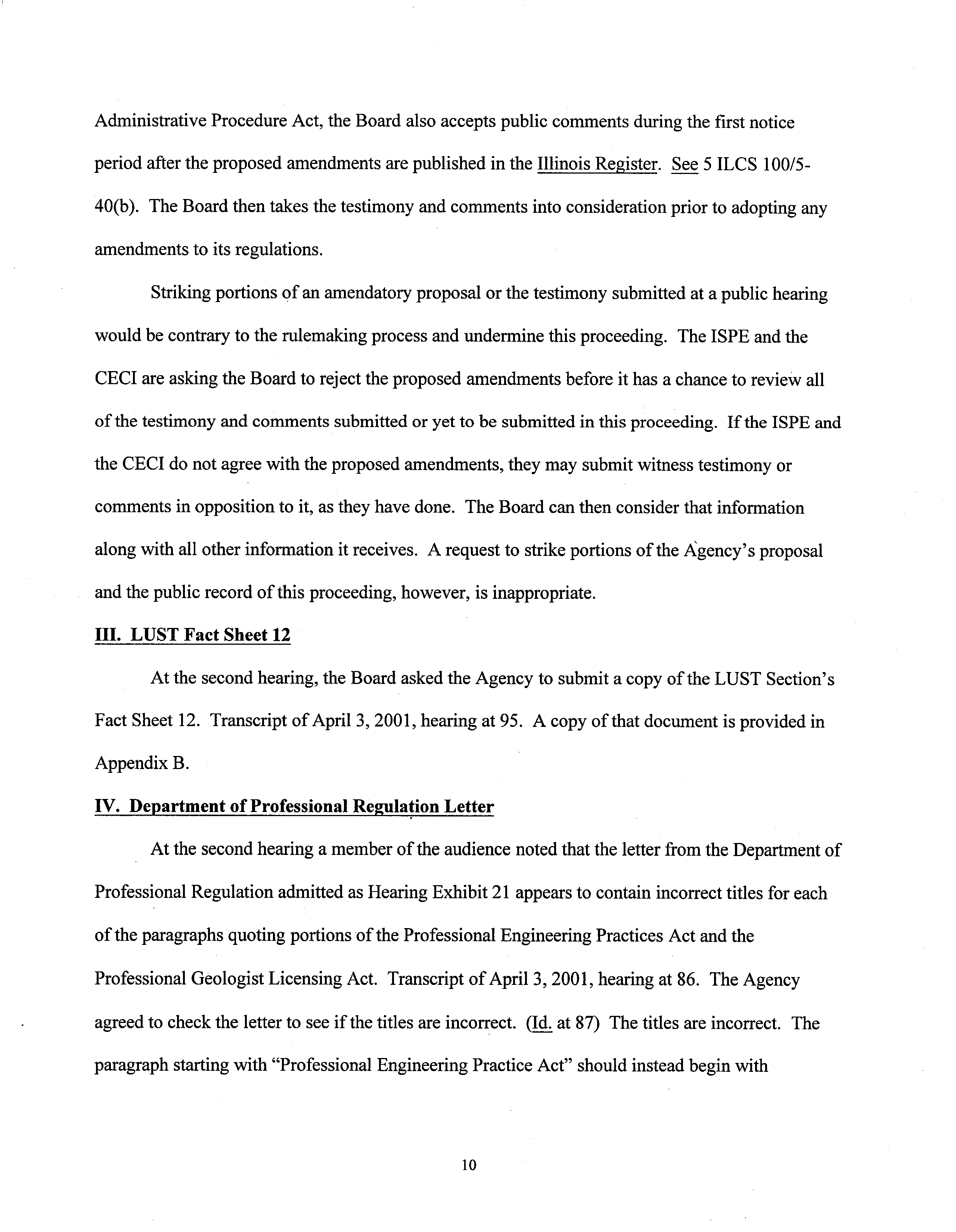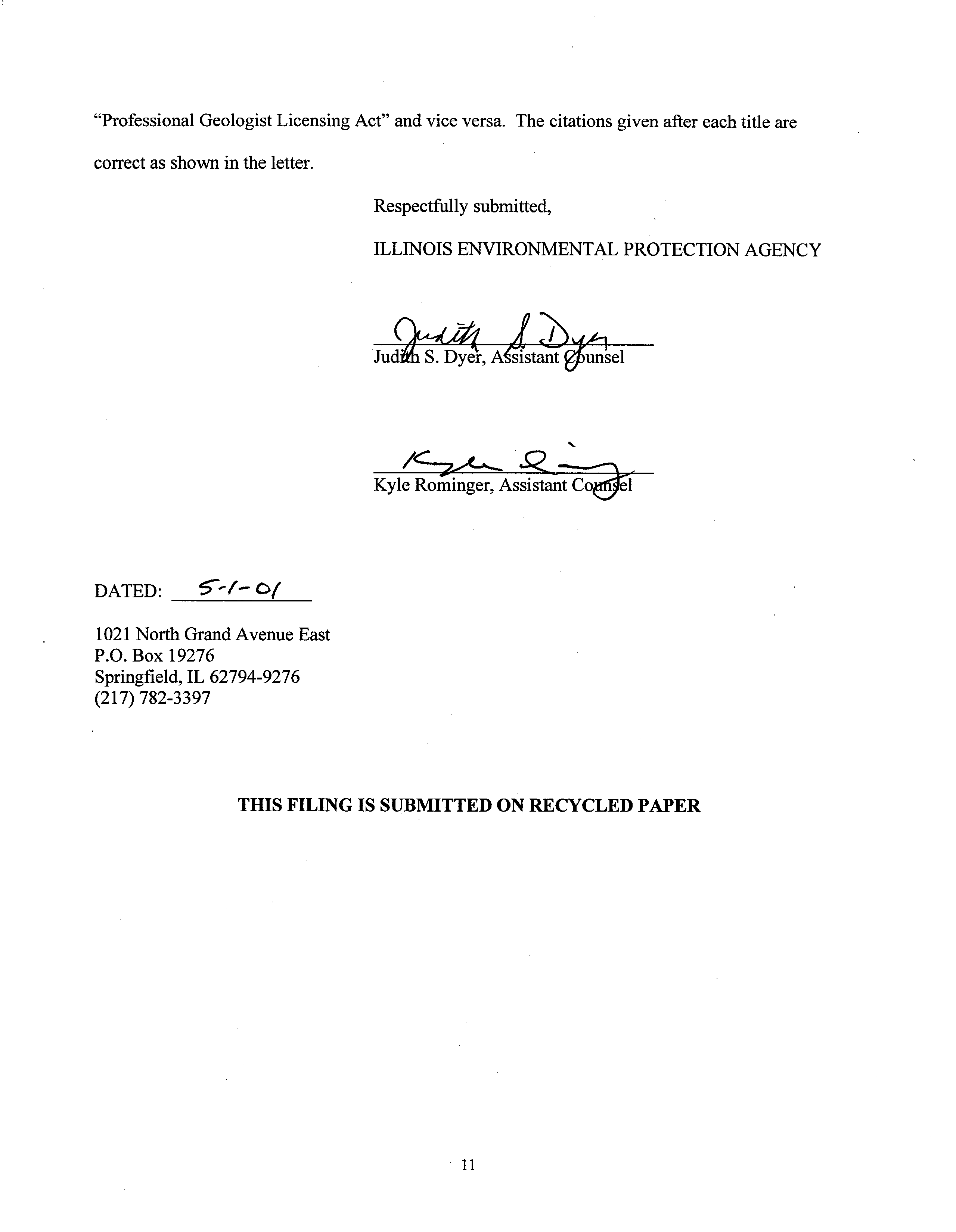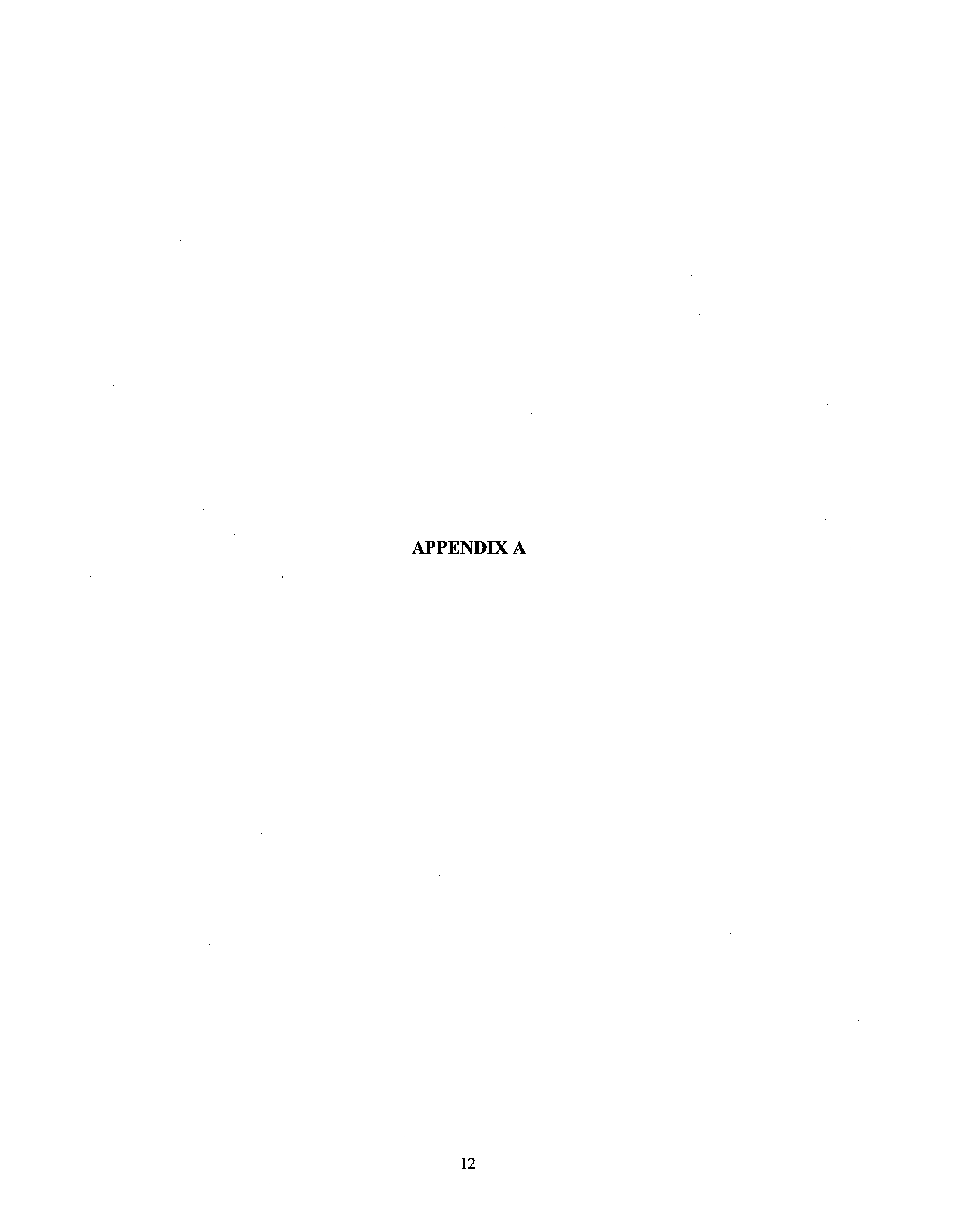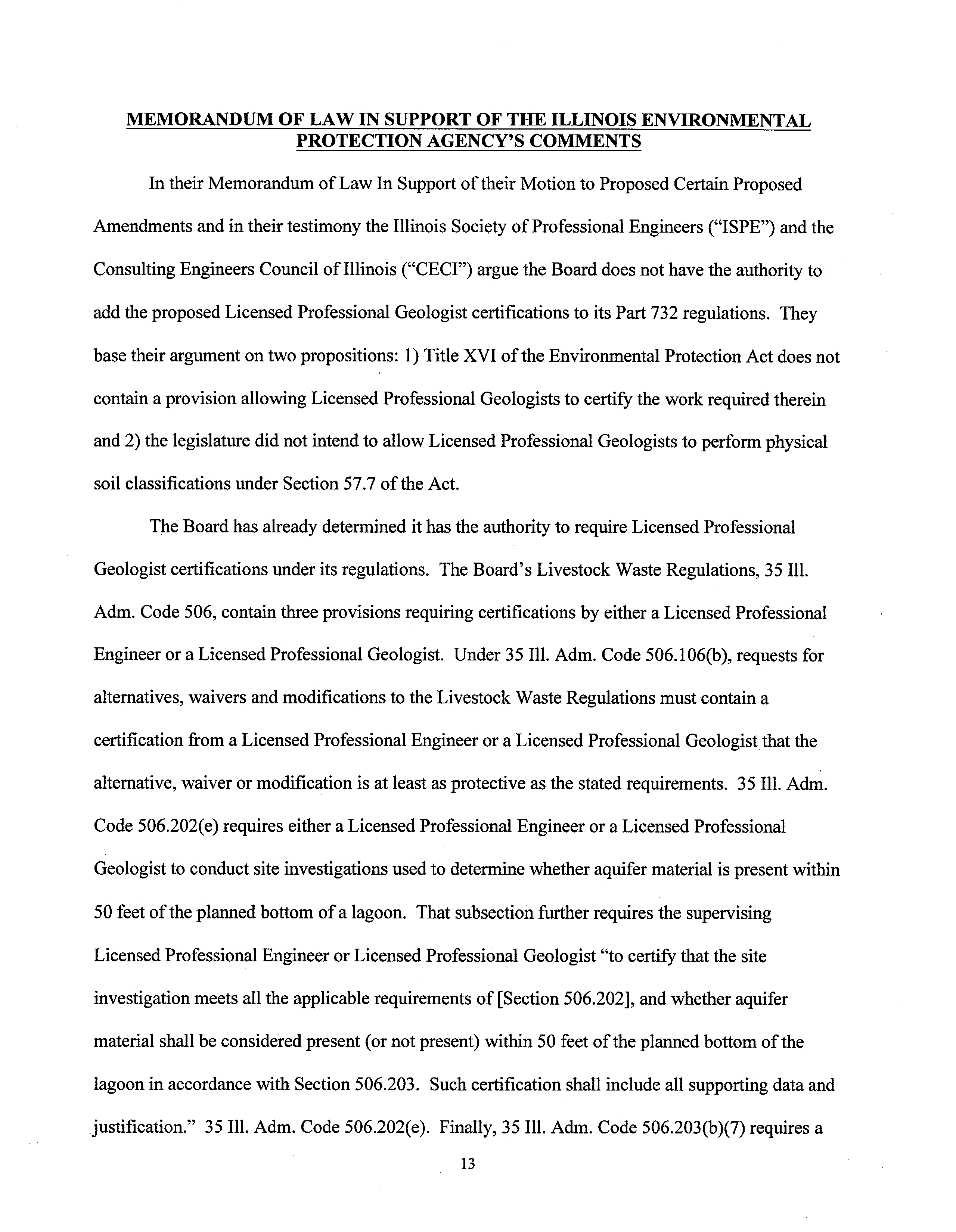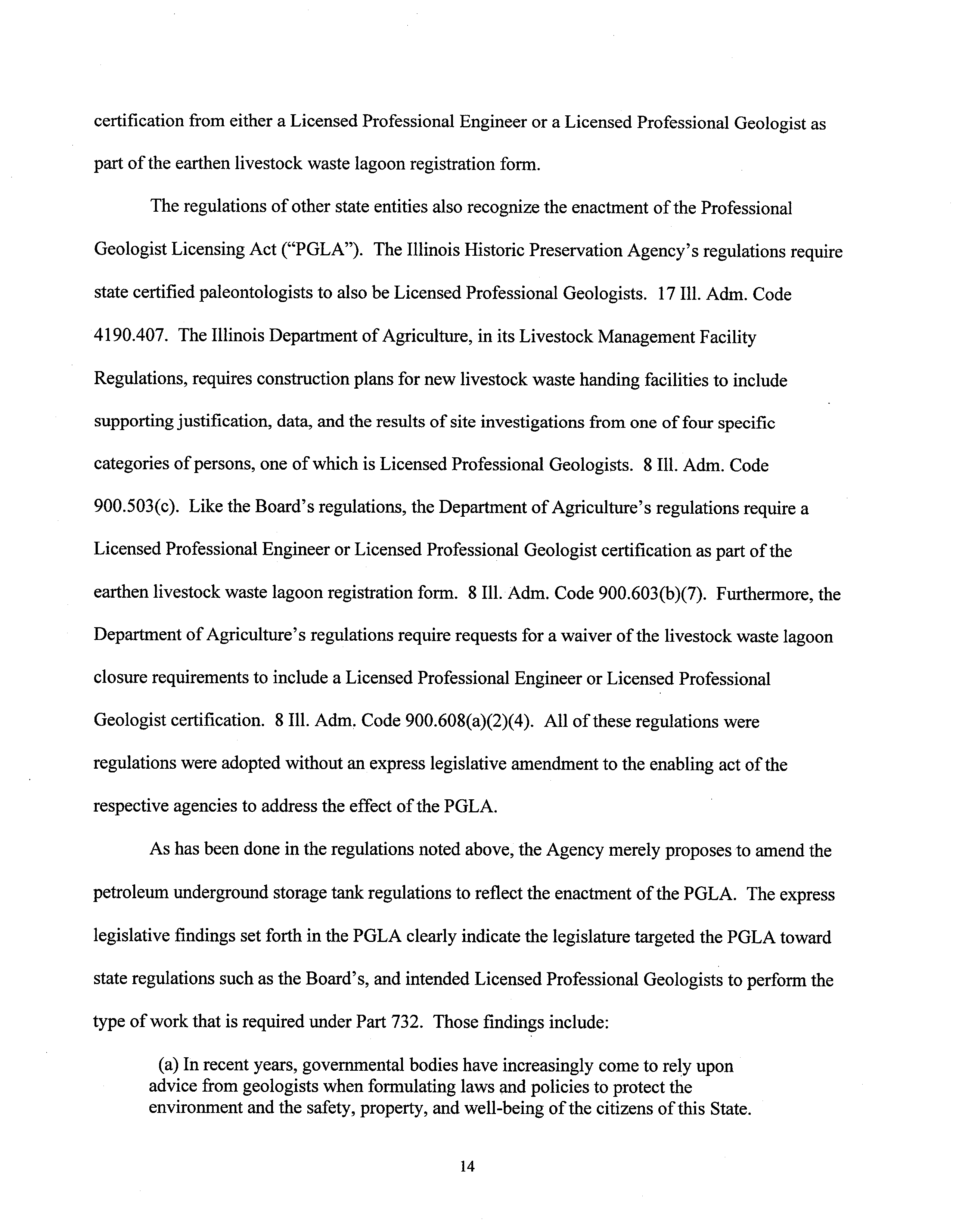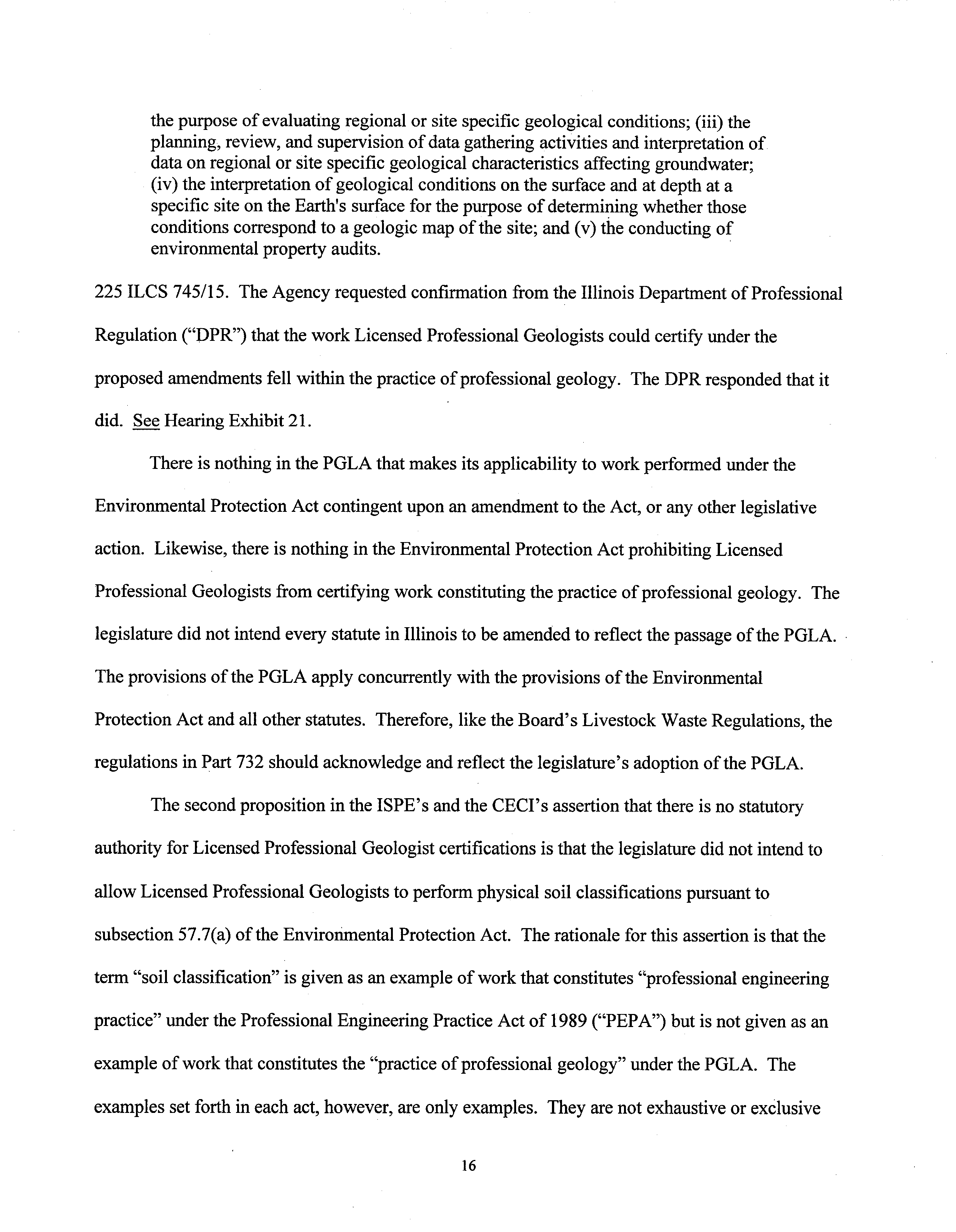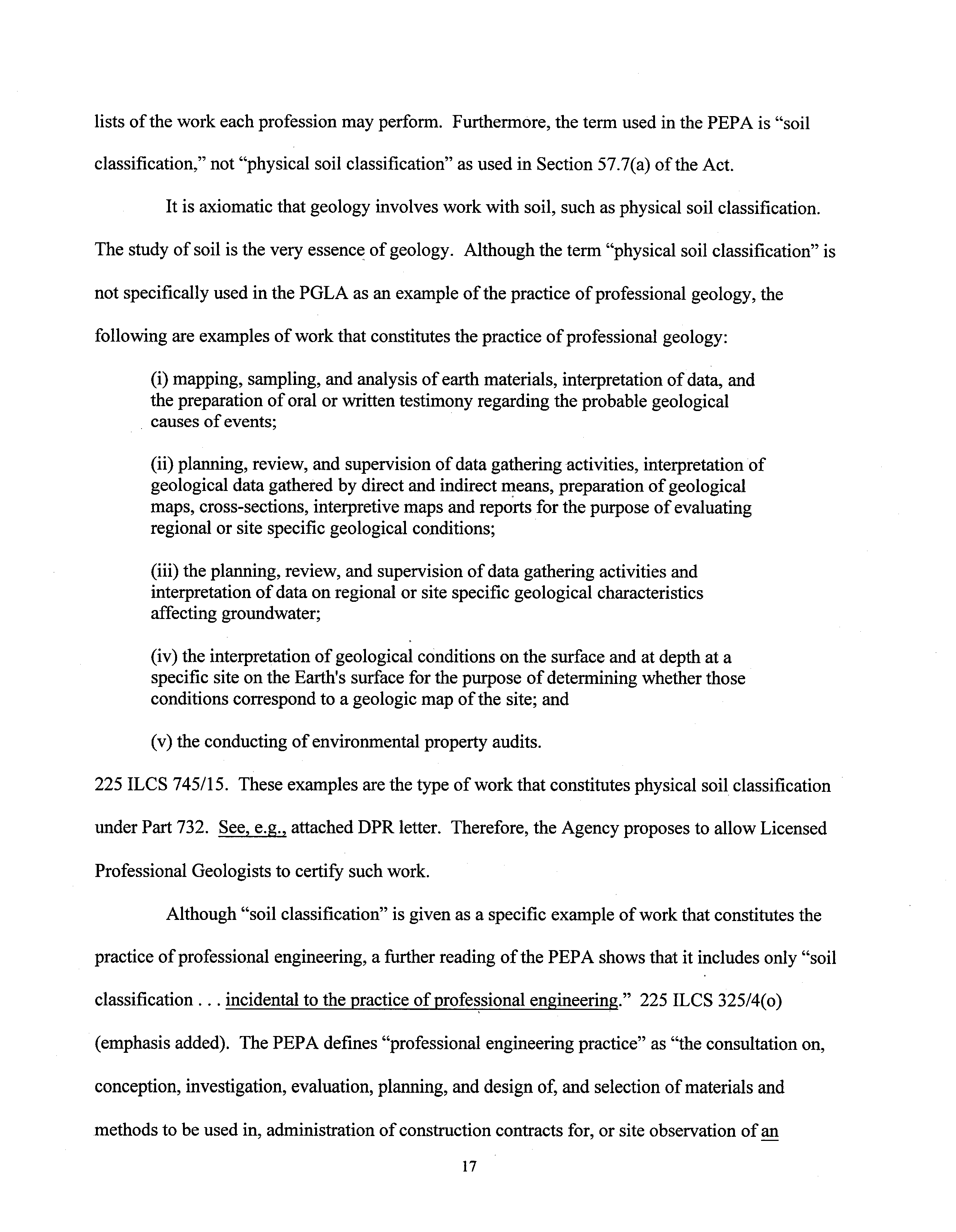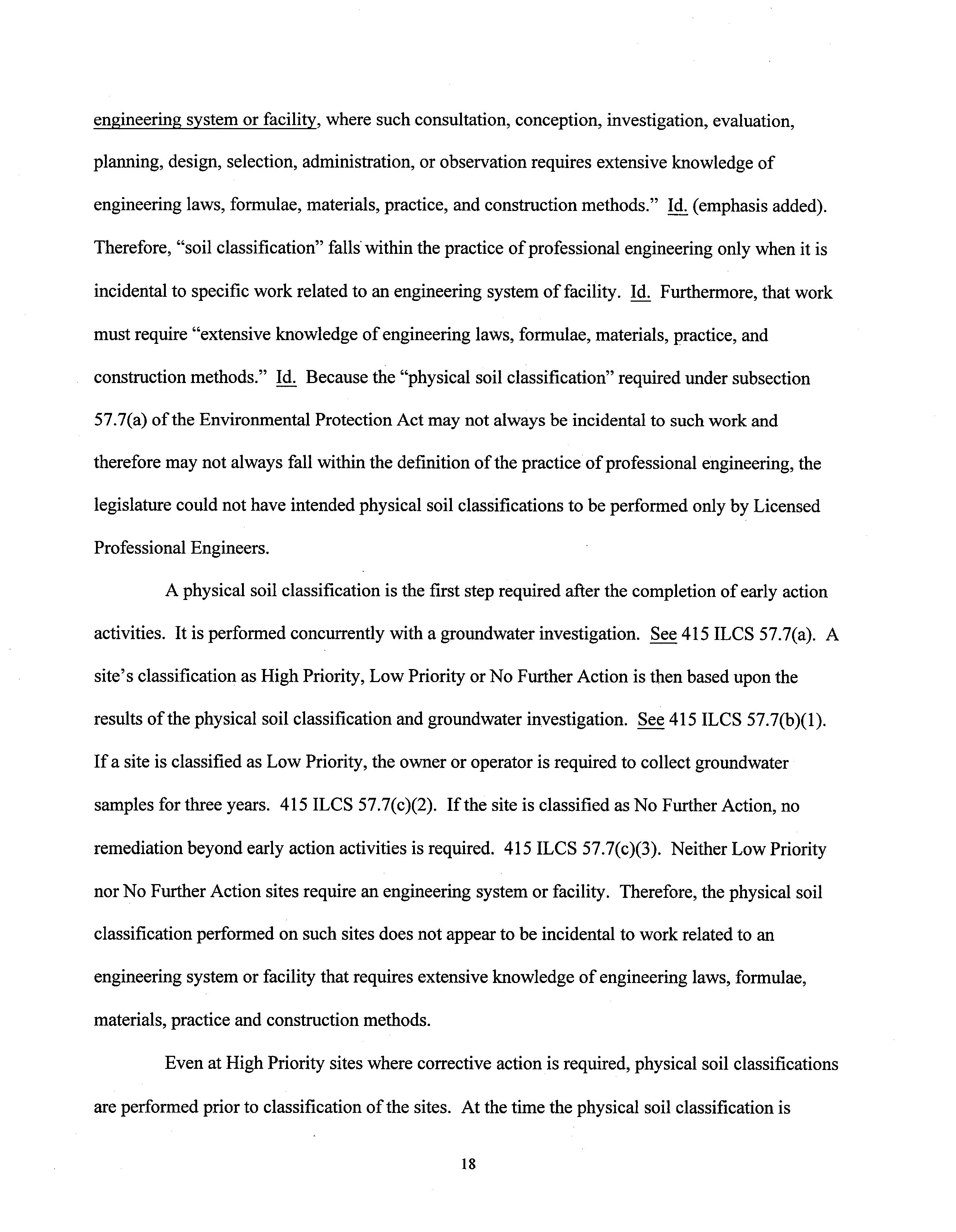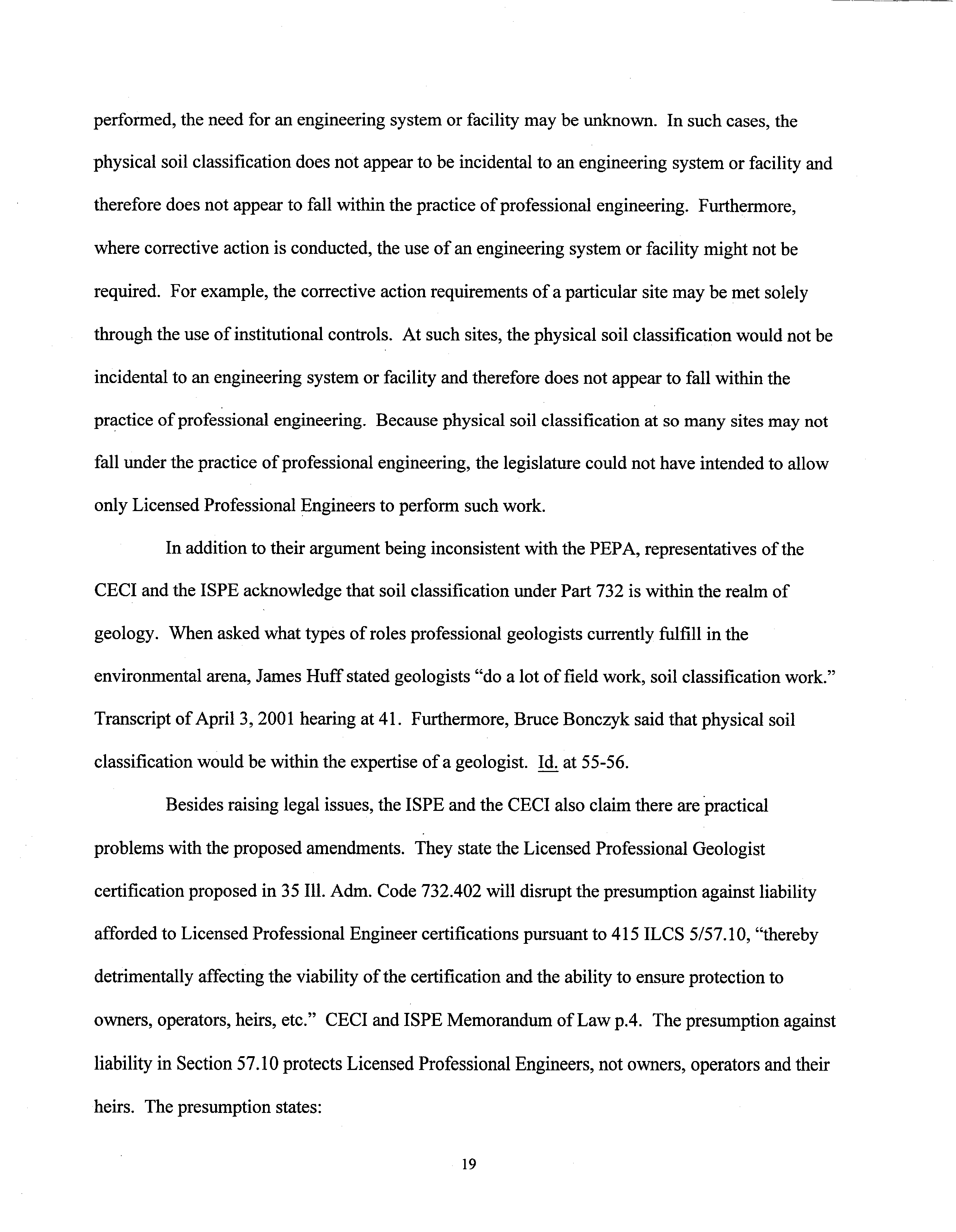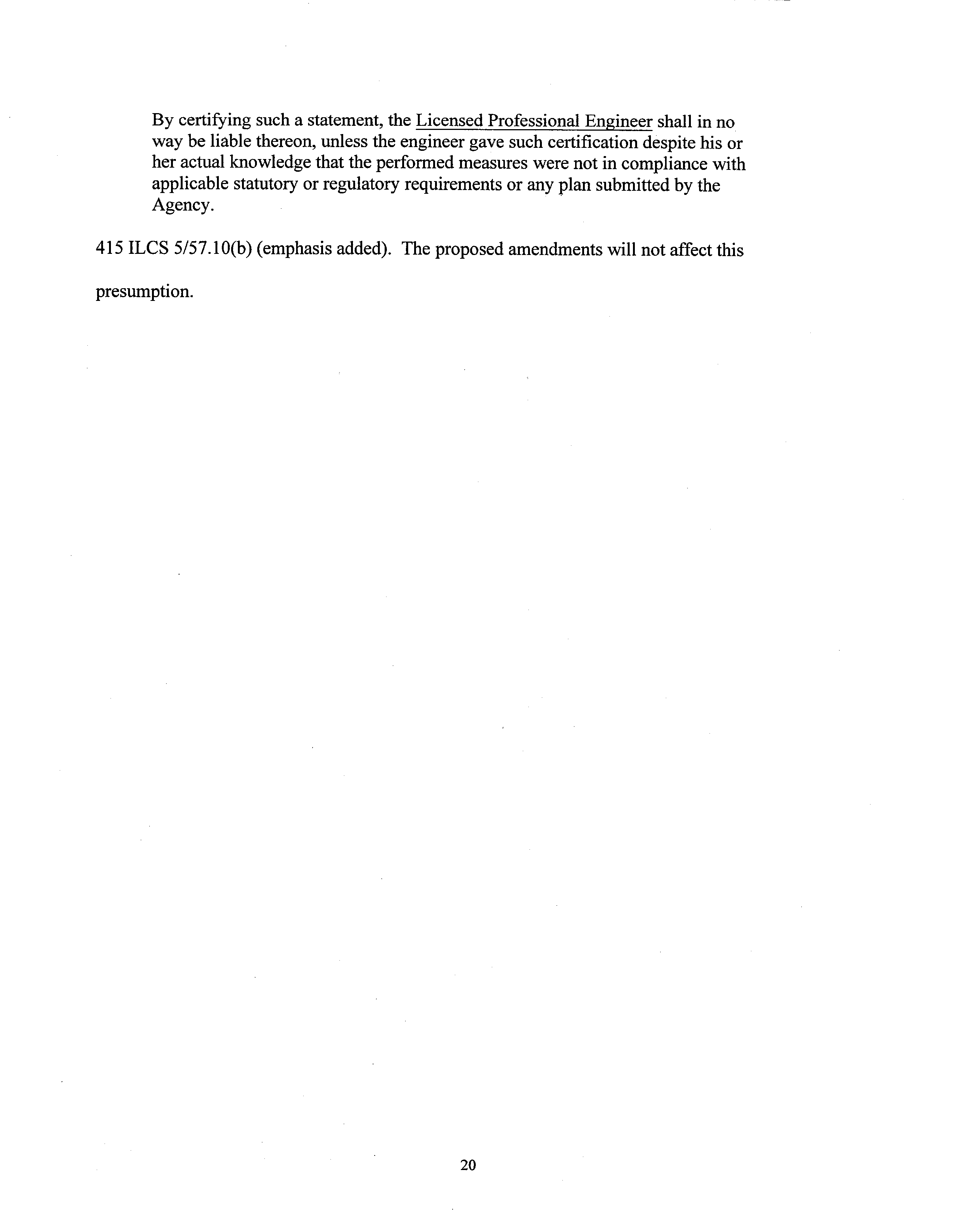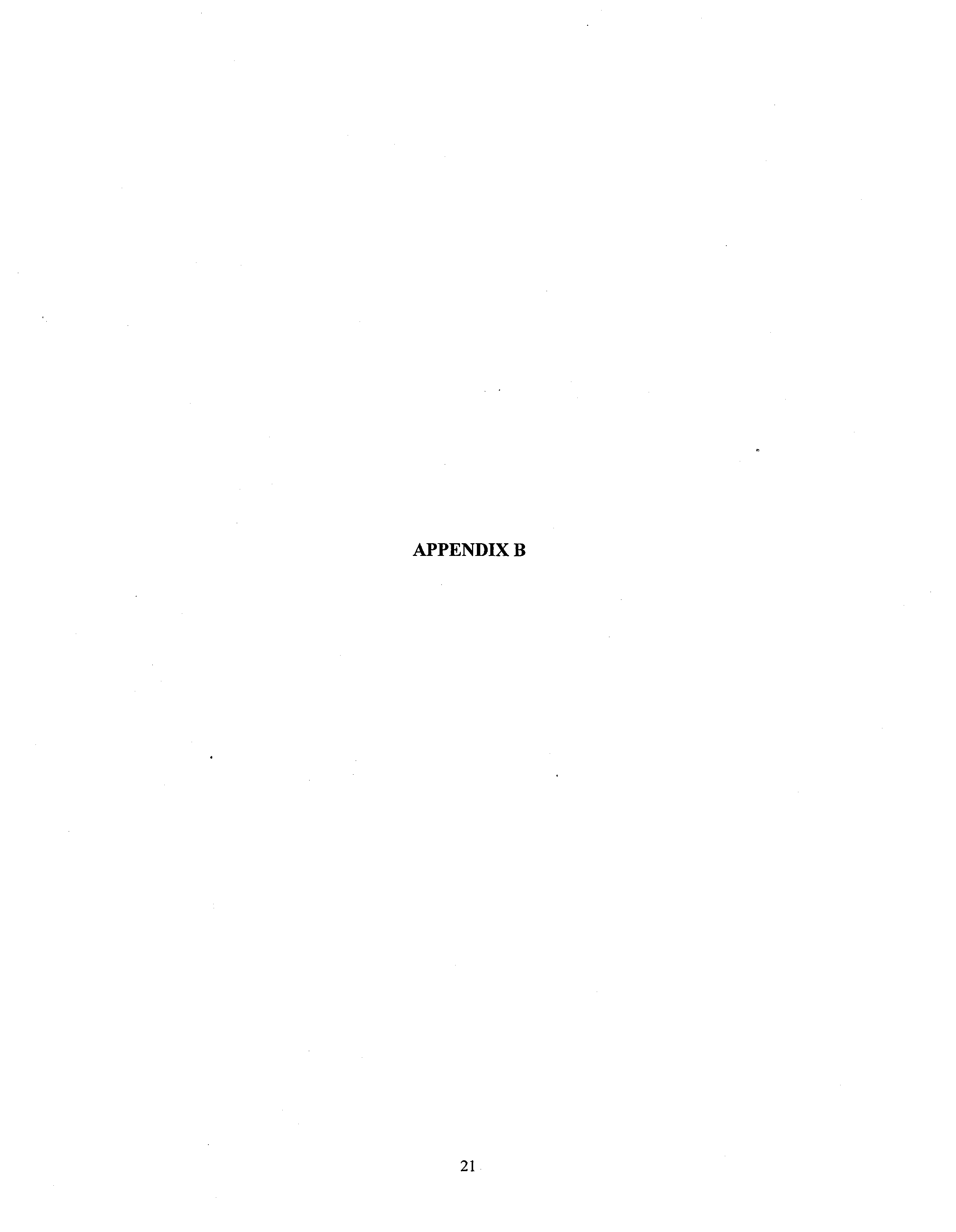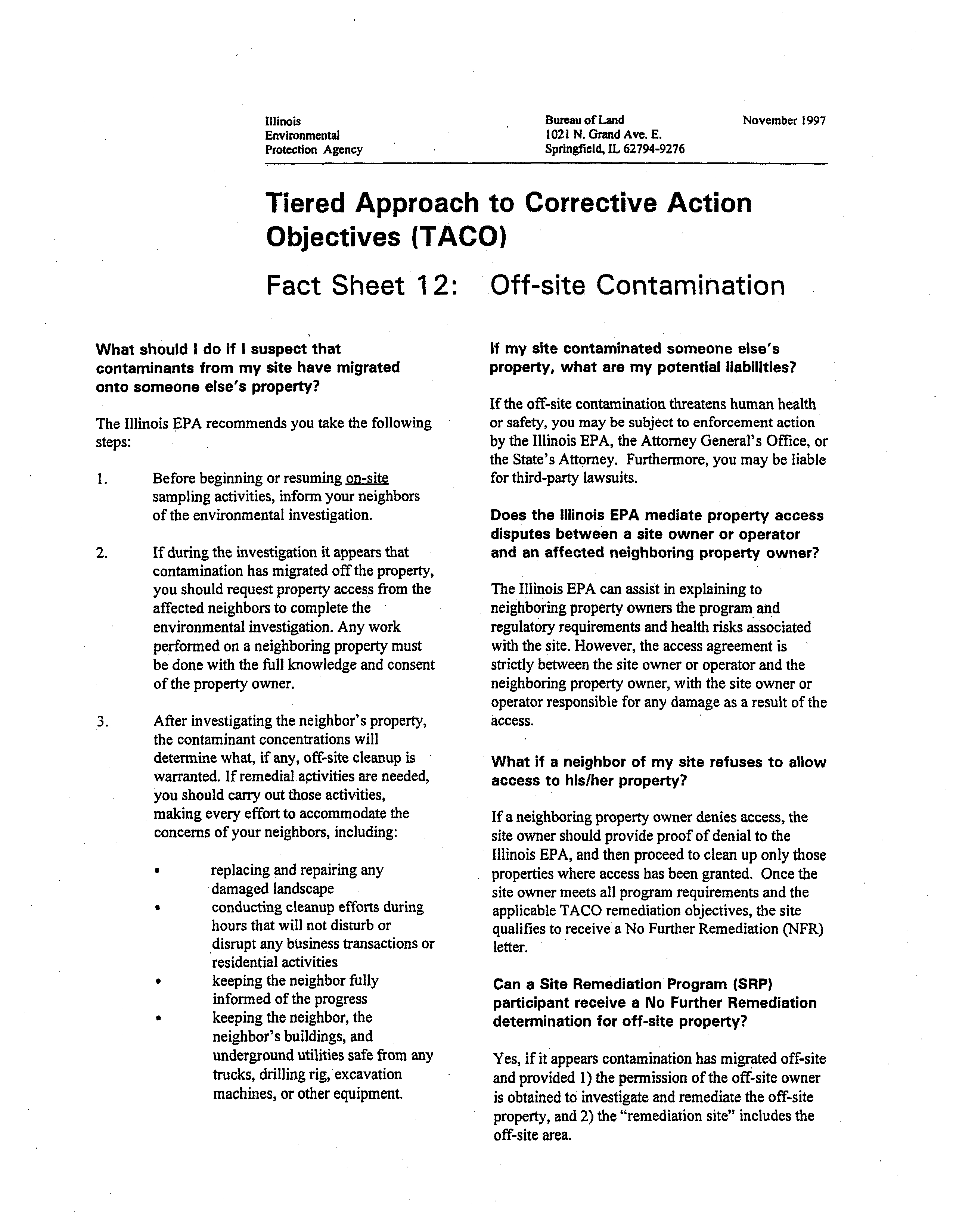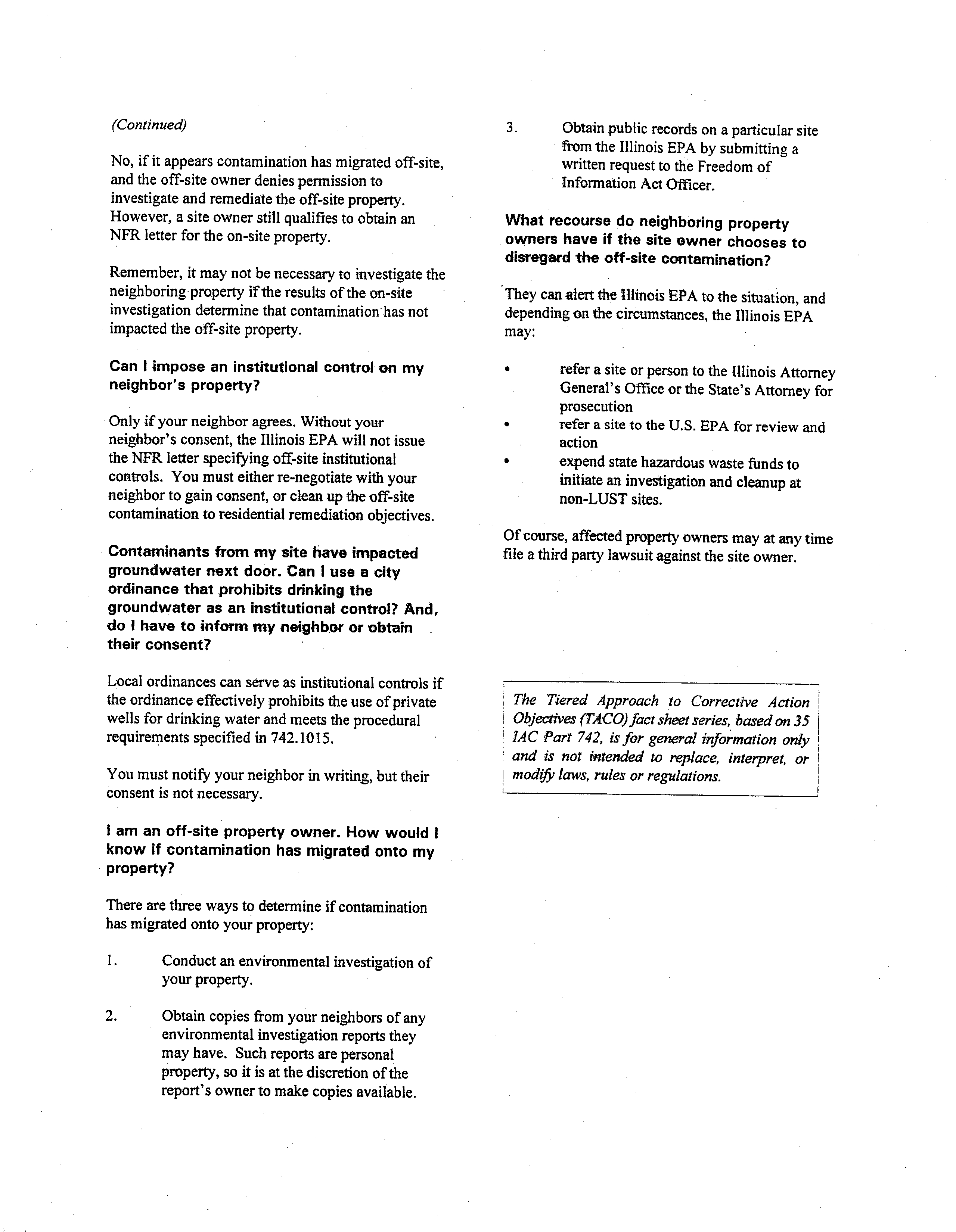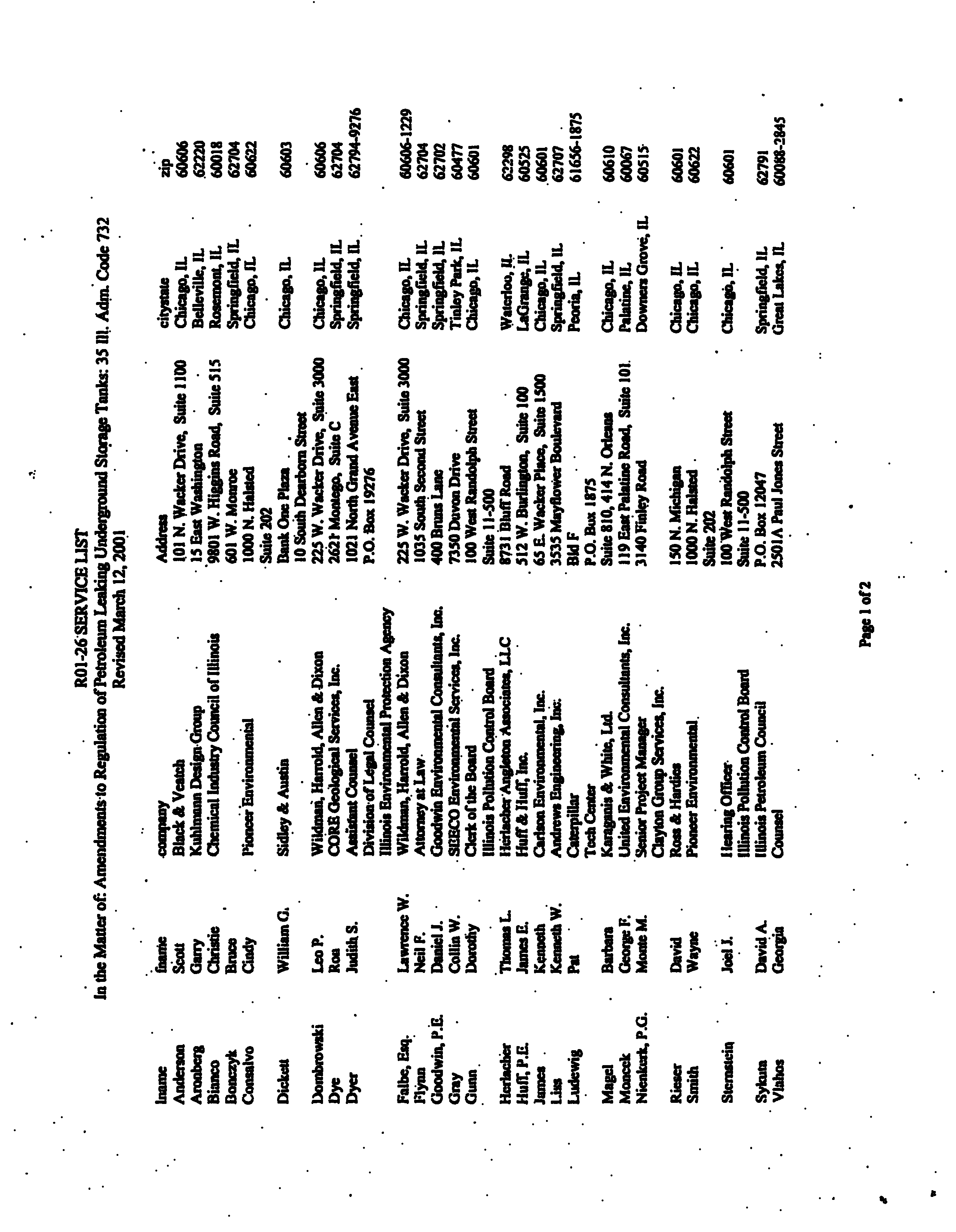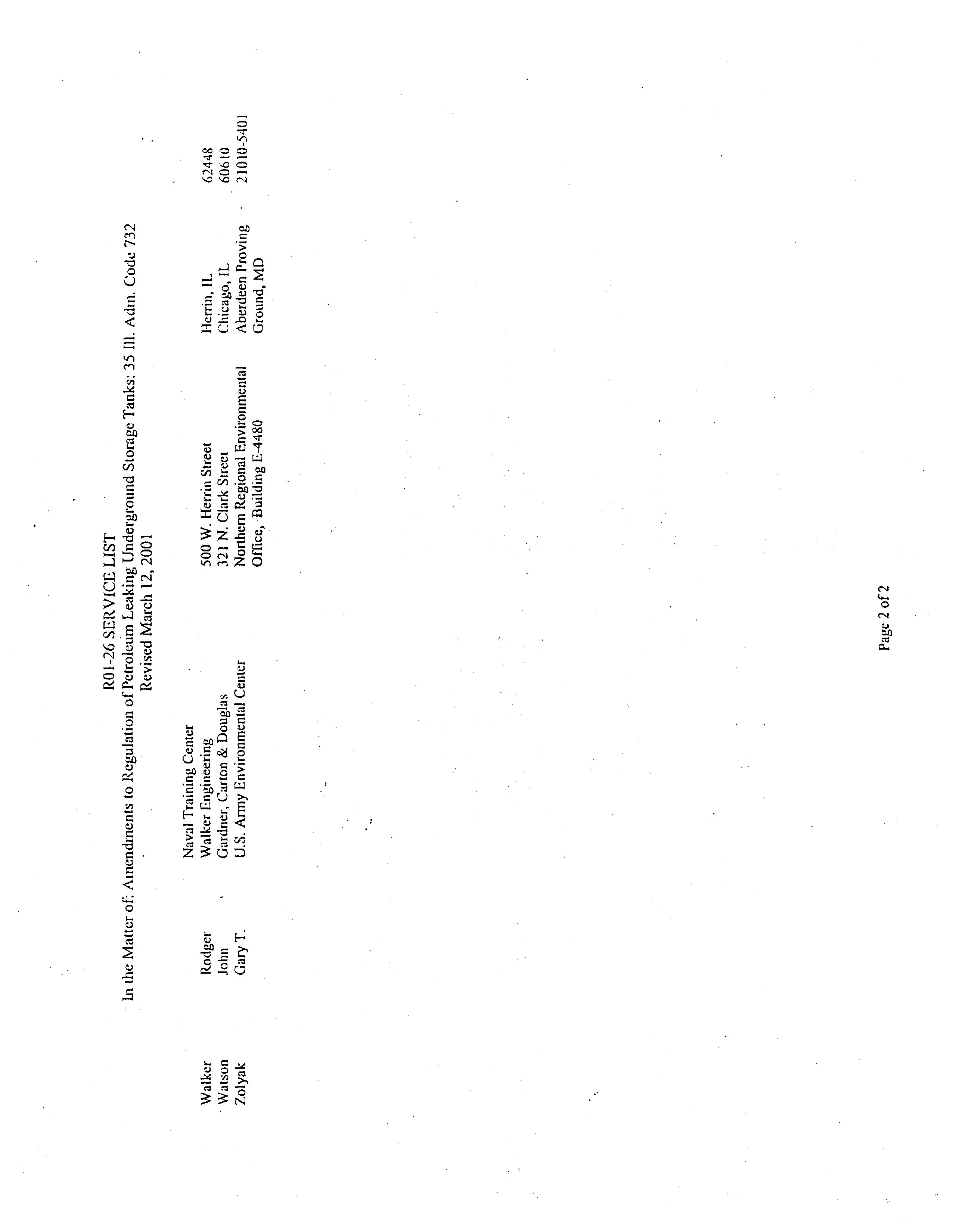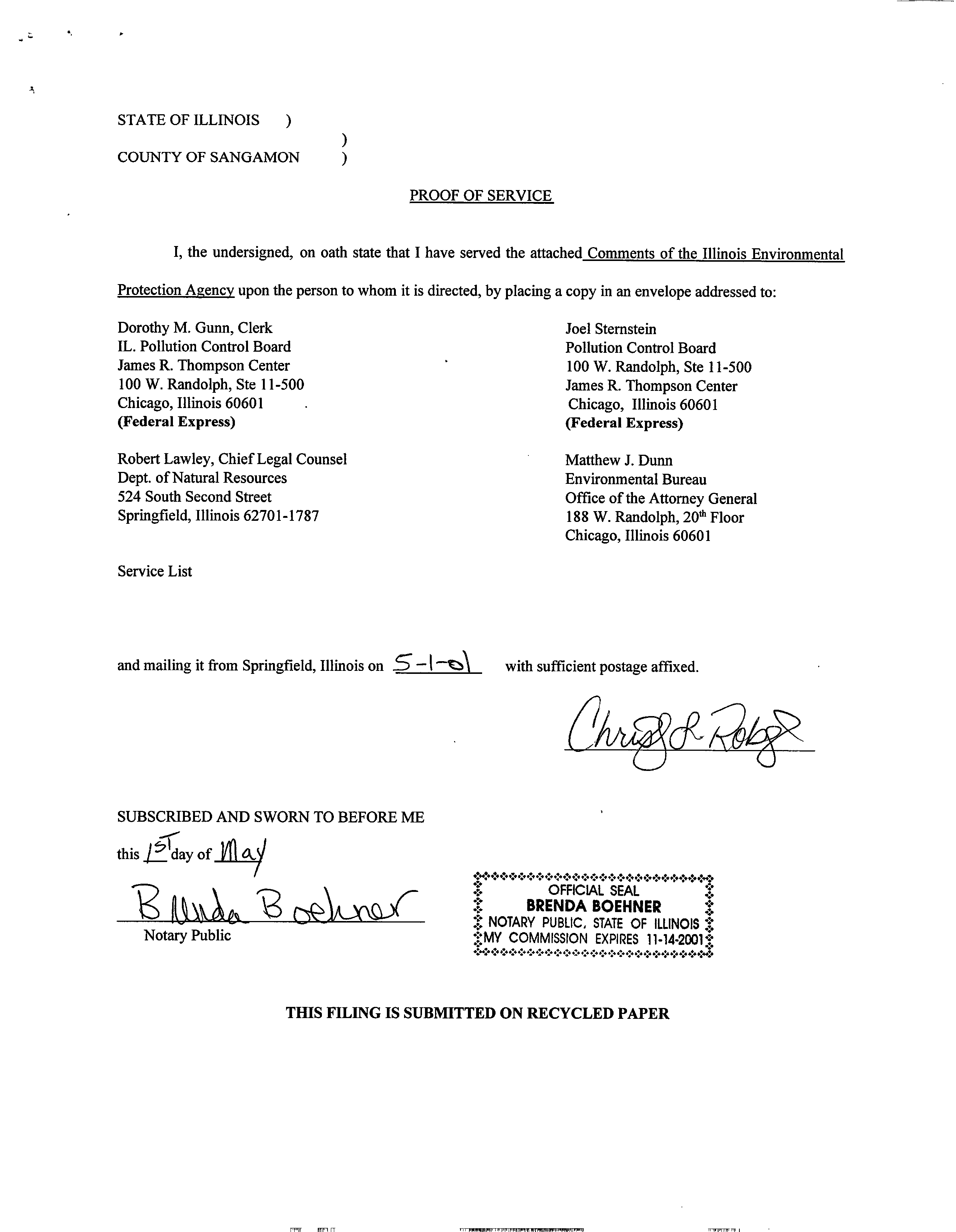BEFORE
THE POLLUTION CONTROL
BOARD
OF THE STATE OF ILLiNOIS
RECEIVED
CLERK’S OFF~CF
MAY
2
-
2001
STATE OF ILLINOIS
Pollution
ControlBoard
IN THE MATTER OF:
REVISION OF THE PETROLEUM
UNDERGROUND STORAGE TANK
REGULATIONS: PROPOSED
AMENDMENTS
TO 35111. Adm. Code
732
)
)
)
)
)
)
ROO-26
(Rulemaking-Land)
NOTICE OF FILING
Dorothy M. Gunn, Clerk
Illinois Pollution Control Board
James R.
Thompson Center
100 West Randolph Street, Suite 11-500
Chicago, Illinois 60601
(Federal Express)
Robert Lawley, ChiefLegal Counsel
Dept. ofNatural Resources
524
South Second Street
Springfield, Illinois 6270 1-1787
Joel Stemstein
PollutionControl Board
100 W. Randolph, Ste 11-5001
James R. Thompson Center
Chicago, Illinois 60601
(Federal Exress)
Matthew J. Dunn
Environmental Bureau
Office of the Attorney General
188
W. Randolph,
20th
Floor
Chicago, Illinois 60601
Service List
NOTICE OF FILING
PLEASE TAKE NOTICEthat I havefiled today with the Illinois PollutionControl Board the Comments of
the Illinois Environmental ProtectionA~encv by the ENVIRONMENTAL PROTECTION AGENCY, a copyofwhich
is herewith served upon you.
ENVIRONMENTAL PROTECTION AGENCY
OF THE STATE OF ILLINOIS
By:
2-~9-~~~
2’~
Judith
d.
Dyerd
#~
AssistantCounsel
Division of Legal Counsel
Dated: May 1,2001
Illinois Environmental Protection Agency
1021
North Grand Avenue East
P.O. Box 19276
Springfield, Illinois
62794-9276
(217) 782-5544
By:
~in~r~N
AssistantCounsel
Division of Legal Counsel
THIS FILING IS SUBMITTED ON RECYCLED PAPER
RECEIVED
CLERK’S OFFICE
MAY 2
-
2001
BEFORE THE ILLINOIS POLLUTION CONTROL BOARD
STATE OF IWNOIS
Pollution
Control Board
liNT THE MATTER OF:
)
)
REVISION OF THE PETROLEUM
)
ROO-26
UNDERGROUND STORAGE TANK
)
(Rulemaking
-
Land)
REGULATIONS:
PROPOSED
)
AMENDMENTS TO 35111.
Adm. Code
732)
COMMENTS
OF THE ILLINOIS ENVIRONMENTAL PROTECTION AGENCY
NOW COMES the Illinois Environmental Protection Agency (“Agency”), byits attorneys,
and submits the following comments in the above-referenced rulemaking:
I.
Off-site Access
Introduction
Part 732 currently contains a provision, set forth at Section 732.404(b)(l)(A), that owners or
operators must design their corrective action plans
such that,
after complete performance
of the
plan, applicable
indicator contaminants “are notpresent in groundwater, as a result ofthe release, in
concentrations exceeding the remediation objectives referenced in
Section 732.408
at the property
boundary or 200 feet from the UST system, whichever
is less.”
An exception to this requirement is
provided, stating that “ifan adjoining property owner will not allow the owner or operator access to
his
or her
property
so as to ascertain information
sufficient
to satisfy this
requirement or if the
owner cannot be located, adequate documentation ofthe owner or operator’s efforts to gain access
to the property shall satisfy this subsection (b)( 1 )(A).” This exceptionis
intended to apply when an
owner or operator encounters a recalcitrant or unavailable off-site property owner.
The Agency has proposed striking the portion of Section 732.404(b)(1)(A) that contains the
exception.
To replace the stricken portion, the Agency
proposed
the amendments
set
forth
in
Sections 732.404(c)
and 732.411. These proposed amendments preserve the exception, but with the
introduction
of a “best efforts” concept,
which is intended to establish a formal means for the
Agency
to
evaluate,
on
a
site-specific
basis,
the
adequacy
of
the
effort
made
by
the
owner
or
operator to gain off-site access.
The
Illinois
Petroleum
Council
(“IPC”) has proposed alternative
language addressing
off-
site access. The IPC proposal differs from the Agency’sproposed language in several respects.
In
these comments, the Agency presents,
for the Board’s consideration, support
for the Agency’s
proposed language addressing this issue and feedback
on the IPC proposal.
1.
Support for Agency Proposed Language
The Agency submits the following comments in support ofthe language proposed by the
Agency to address off-site access:
A.
Content ofLetter
Section
732.411(b), as proposed by the Agency, requires
1an owner or operator to provide, by
certified mail, certain statements the Agency has identified as neK~essary to convey to
an off-site
property owner the possible ramifications ofdenying access.
TINe off-site property owner must be
apprised that,
by denying access, he or she effectively forfeits hi~ or her opportunity to have the
owner or operator, as part ofa LUST remediation effort,
address~contamination on his or her
property resulting from a release for which the owner or operatov is responsible, and that it will be
more difficult to have the owner or operator clean up his or her property once an NFR letter has
been issued.
The IPC has proposed modifications to the required cont~nts ofthe letter. The Agency
objects to some ofthe changes to this subsection proposed by IPC and has no objection to others;
for specifics, see the discussion under the Agency’scomments
o~i the IPC proposal.
B.
Use ofCertified Letter
The Agency has proposed requiring that the letter sent to the off-site property owner be
sent
by certified mail. A certified letter is necessary due to the signifi~ance ofthe possible consequences
2
resulting from an owner or operator’s failure to obtain
off-site access.
By denying
access,
the off-
site property owner is in effect forfeiting his or her opportunity to have any contamination on his or
her property for which the owner or operator is responsible addressed without litigation.
A certified
letter provides proofofreceipt of the letter by the off-site owner.
The IPC suggested at hearing that a certified letter ofthe sort described might be an overly
intimidating means of informing the off-site owner ofthe need to gain access to his or her property.
The Agency does not intend that the letter be used as a means offirst contact or in all cases.
The
Agency endorses the approachpresented by IPC, in David Piotrowski’s testimony, forattempting to
gain access.
Owners and operators are encouraged to pursue less intimidating efforts to obtain
cooperation from off-site property owners.
The certified letter is viewed as a more aggressive
tactic, required only in
instances in which an off-site property owner proves uncooperative after
other means ofgaining access have failed.
In such cases, proofofdelivery ofa certified letter
serves as documentation to the Agency ofthe owner’s or operator’s effort to gainaccess.
C.
Best Efforts
The “best efforts” concept introducedby the Agency was taken from federal rules applicable
to hazardous waste treatment,
storage and disposal facilities.
See 52
FR 45788, Attachment to
Testimony ofDoug Clay in Support ofthe Environmental Protection Agency’sProposal to Amend
32 Ill.
Adm. Code 732.
In the Preamble adopting amendments to those rules, the USEPA stressed
the necessity ofconsidering on a case by case basis what constitutes best efforts to gain off-site
access.
Like the USEPA, in order to protect humanhealth and the environment, the Agency must
have the discretion, in the context ofLUST remediations, to consider the site-specific circumstances
in assessing whether the owner or operator has demonstrated “best efforts.” At a minimum, the
owner or operator must demonstrate that the off-site owner has received the certified letter required
3
pursuant to Section 732.411(b).
Beyond that, the Agency must be able to consider whether any off-
site contamination may have an impact on sensitive environments or parties other thanthe off-site
owner, e.g. a daycare leasing the off-site property, residential renters on the property of the off-site
property owner, other property owners, etc. The Agency must have the discretion to consider the
scenarios identified by the IPC
-
the presence offree product, the presence of fire, explosion, and
vapor hazards, and the presence of potable water wells, surface water, setback zones or regulated
recharge areas.
However, the Agency must also be able to take into consideration other scenarios
creating a threat ofharm in determining whetherto deny an NFR letter for failure to obtain off-site
access such as those noted above.
The Agency cannot anticipate, and thus cannot enumerate, all ofthe circumstances that
would lead to a denial ofan NFR for failure to gain access.
Using the best efforts approach, with
consideration ofthe factors outlined in the Agency’sproposed subsection 732.411(d), the Agency
certainly will be able to determine when circumstances warrant denial ofan NFR letter.
In the
event ofa denial by the Agency, the owner or operator is not without recourse, as the denial is
appealable to the Board.
2.
Evaluation ofIPC Proposed Language
The Agency, after having an opportunity to review the language proposed by the IPC, has
the following comments
on the IPC proposal:
732.404(c
The Agency has no objection to the addition of“or off-site” in the firstsentence.
The Agency does not object to adding “ofthis Part” to the end ofthis Section,
but does
object to the remainder ofthe language added to the end ofthe paragraph.
See discussion under
732.41 1(d)(2) for the basis ofthis objection.
4
Section 732.411(a
The Agency has no objection to IPC’sproposed relocation ofthis language to 732.411(f).
Section 732.411(b
The Agency objects to striking “at a minimum” in the prefatory language ofsubsection (b).
Depending upon site-specific circumstances, sending the described letter may or may not constitute
the best efforts necessary to gain off-site access (for example, when an off-site property owner has
denied an owner or operator access, but contamination on the off-site property threatens to
contaminate groundwater downgradient from the off-site property).
In cases where a letter is
insufficient, the Agency needs the discretion to deny an owner or operator’s request for an NFR
letter due to the owner or operator’sfailure to use best efforts.
The Agency objects to all changes made to subsection (b)(1), due to the resulting lack of
clarity. The language proposed by the Agency sufficiently describes an owner or operator’slegal
responsibility to remediate any contamination resulting from a release from the owner or operator’s
UST.
The Agency has no objection to changes made to subsection (b)(2).
The Agency has no objection to striking subsection (b)(3).
The Agency has no
objection to the addition ofnew subsection (b)(3).
The Agency has no
objection to striking subsection (b)(4), provided that IPC’s proposed
(b)(3) is added.
The Agency objects to striking subsection
(b)(5).
The Agency believes off-site property
owners should be informed that they are not liable to pay for costs of remediating contamination
caused by a release for which the owner or operator is responsible. The owner oroperator should
inform the off-site owner that the owner or operator will pay for remediation ofcontamination
resulting from the owner or operator’srelease.
5
The Agency objects to the addition ofnew subsection (b)(4).
“Work[ing]
to resolve issues
arising from release” does notaccurately reflectthe owner or operator’sresponsibility to remediate
the contamination resulting from the release.
The Agency would not object to language clarifying
that the scope ofthe owner or operator’s responsibilityis limited
to remediation of contamination
resulting from the release for which the owner or operator is responsible.
The Agency objects to striking subsection
(b)(5).
As pointed out by Board Member Melas
at the second hearing, this is a true statement (transcript p.
67). The consequences set forth are
couched in terms of“may”rather than shall. Such a statement is needed to alert the off-site owner
to the gravity ofharm that may result from any contamination on his or her property.
The Agency has no objection to striking (b)(7), as long as the IPC’sproposed (b)(3) is
added.
Section 732.411(d
The Agency objects to striking subsection (d).
The Agency needs to make the owner or
operator aware ofthe information that will be considered in determining, based on site-specific
conditions, whether the owner or operator has used best efforts to gain off-site access. Current
regulations require that the owner or operator provide “adequate documentation”ofhis
or her
inability to gain access.
The Agency’s practicehas been to consider the information listed in
proposed subsection (d) in implementingthis requirement.
Thus, this language clarifies what the
Agency currently considers in determining whether the owner or operator has provided “adequate
documentation.” The proposed amendments set forth the information the Agency will consider in
determining whether the owner or operator has conducted “best efforts.”
The concept of“best efforts,”taken from the USEPA, is intended to allow consideration of
site-specific circumstances.
There will be no additional cost to the owner or operator in having the
Agency consider the enumerated factors, as the information listed will already have been submitted
6
by the owner or operator in the course ofthe LUST remediation effort.
Section 732.411(e
The Agency objects to the striking of“and otherwise entitled to such issuance” in subsection
(e).
The owner or operator is required to meet all other applicable requirements in Part 732 prior to
obtaining an NFR letter.
This language conveys that point.
The Agency objects to replacing “an inability” with “that it has been unable” insubsection
(e)(2).
The owner or operator must demonstrate a lack ofability or means to obtain access not only
during the period prior to the submission of a corrective action completion report but also
afterwards.
The Agency objects to the language added at the end ofsubsection (e)(2) (“and theAgency
has not found that the contamination remaining off-site poses an imminent threat ofharm to human
health or the environment”).
By restricting the scope ofthe standard to threats that are imminent,
this language creates a less stringent
standard thanthat set forth in the Act.
As
the Agency points
out in its discussion ofthe “best efforts”concept, circumstances at a site maywarrant denial ofan
NFR letter in cases
where there is not an imminent threat ofharm to human health orthe
environment. Also, the proposed language places the burden on the Agency to make a finding.
The
burden should be
on the owner or operator to demonstrate to the Agency that it has complied with
the requirements of this Section.
In addition, even ifthis language were not objectionable on other
grounds, it would not belong in this subsection. Subsections (e)( 1) and (e)(2) provide requirements
applicable to the owner or operator, not the Agency, i.e. the owner or operator must either complete
any requisite off-site corrective action or demonstrate to the Agency’s satisfactionan inability to
obtain off-site access despite the use ofbest efforts.
Tacking on a requirement in this subsection
that is applicable to the Agency
-
that the Agency make a finding as to the degree of threat posed by
contamination remaining on the off-site property
-
does not make sense.
7
The Agency objects to subsection (e) in its entirety. As already stated, the Agency objects
to the proposed “imminent threat ofharm” standardas not sufficiently stringent.
In addition, the
factors proposed by IPC reference immediate threats only to human safety.
The Agency’sconcerns
do not fit within these limited specific scenarios.
The language does not take into account the vast
array ofcircumstances that may be
present at a site and threaten human health and the environment.
The Agency proposed a case-by-case, site-specific evaluation ofeach site, rather than an
enumeration ofspecific circumstances, due to the wide variety ofcircumstances that may be present
and the inability to cover every situation.
Section 732.411(f
The Agency has no objection to the relocation ofthis language
from subsection 732.411(a).
II.
Licensed Professional Geolo2ist Certifications
In their Motion to Oppose Certain Proposed Amendments, which the Board has indicated
will be taken as comments, the Illinois Society ofProfessional Engineers (“ISPE”) and the
Consulting Engineers Council of Illinois (“CECI”) assert the Agency has “exceeded theauthority of
its rulemaking powers” by proposing the amendments now before the Board.
(ISPE and CECI
Motion p.1) They further claim “the Agencyhas insufficient statutory authority
as a matter oflaw
to include
[Licensed Professional Geologists] via its rulemaking process.” (ISPE andCECI Motion
p.1)
The Agency has not exceeded its rulemaking powers in the current proceeding.
Part 732
contains Board regulations, not Agency regulations.
The Agency has no rulemaking powers in this
proceeding.
It merely proposed amendments to the Board’sregulations as allowed by Section 28 of
the Illinois Environmental Protection Act [415 ILCS
5/28(a)]
(“Anyperson may present written
proposals forthe adoption, amendment, or repeal ofthe Board’s regulations.”) The Act does not
8
place any limitations on amendments proposed by the Agency.
The Act places limitations only on
proposals by others.
See 415 ILCS
5128(a)
(non-Agency proposals must be supported by an
adequate statement ofreasons, must be accompanied by a petition signed by at least 200 persons,
cannot be plainly devoid of merit and cannot deal with a subject on which a hearing has been held
within the preceding 6 months).
The decision ofwhether the proposed amendments are appropriate and should be adopted as
regulations will be made by the Board.
As set forth in the Agency’s Memorandumof Law in
Appendix A, much ofthe work required under Part 732 constitutes the “practice ofprofessional
geology” under the LicensedProfessional Geologists Act, and Licensed Professional Geologists are
authorized by that Act to certify such work.
Furthermore, the Board has already determined it has
the authority to adopt regulations allowing Licensed Professional Geologist certifications.
The
Board’s Livestock WasteRegulations,
35 Ill. Adm. Code
506, require certifications by either a
Licensed Professional Engineer or a Licensed Professional Geologist.
The Agency has merely
proposed amendments that allow Licensed Professional
Geologists to provide certifications in Part
732 as well.
In addition to the above, the relief the ISPE and the CECI request in their Motion is
improper. They ask the Board to strike from the Agency’s proposalany reference to Licensed
Professional Geologists.
They also askthe Board to strike the testimony ofDouglas Clay.
However, there is no provision in the Environmental Protection Act or in the Board’sprocedural
rules that allows such a remedy. Furthermore, such a remedy would subvert the rulemaking
process.
Illinois’ rulemaking procedures are designed to be open.
The Board holds public hearings
in order to invite and receive testimony and public comments
on proposed changes to its
regulations.
Any testimony presented at a hearing is recorded and made available to the public
along with all written comments the Board receives.
415 ILCS
5/28(a).
As required by the Illinois
9
Administrative Procedure Act, the Board also
accepts public
comments during the first notice
period after the proposed amendments are published in the Illinois Register.
See
5
ILCS
100/5-
40(b). The Board then takes the testimony and comments into consideration prior to adopting any
amendments to its regulations.
Striking portions ofan amendatory proposal orthe testimony submitted at a public hearing
would be contrary to the rulemaking process and undermine this proceeding.
The ISPE and the
CECI are asking the Board to reject the proposed amendments before it has a chance to review all
ofthe testimony and comments submitted or yet to be submitted in this proceeding.
Ifthe ISPE and
the
CECI do not agree with the proposed amendments, they may submit witness testimony or
comments in opposition to it, as they have done.
The Board can then consider that information
along with all other information it receives.
A request to strike portions ofthe Agency’sproposal
and the public record ofthis proceeding, however, is inappropriate.
III.
LUST Fact Sheet
12
At the second hearing, the Board asked the Agency to submit a copy ofthe LUST Section’s
Fact Sheet
12.
Transcript ofApril 3, 2001, hearing at 95.
A copy ofthat document is provided in
Appendix B.
IV. Department of Professional Regulation Letter
At the second hearing a member ofthe audience noted that the letter from the Department of
Professional Regulation admitted as Hearing Exhibit 21
appearsto contain incorrect titles for each
of the paragraphs quoting portions ofthe Professional Engineering Practices
Act and the
Professional Geologist Licensing Act.
Transcript ofApril 3, 2001, hearing at 86.
The Agency
agreed to check the letter to see if the titles are incorrect. (Id. at 87)
The titles are incorrect.
The
paragraph starting with “Professional Engineering Practice Act” should instead begin with
10
“Professional Geologist Licensing Act” andvice versa.
The citations given after each title are
correct as shown in the letter.
Respectfully submitted,
ILLINOIS ENVIRONMENTAL PROTECTION AGENCY
Jud~
S.
stant unsel
DATED:
~1
Of
1021 North Grand Avenue East
P.O. Box 19276
Springfield,
IL 62794-9276
(217) 782-3397
THIS FILING IS SUBMITTED ON RECYCLED PAPER
11
APPENDIX A
12
MEMORANDUM OF LAW IN SUPPORT OF THE ILLINOIS ENVIRONMENTAL
PROTECTION AGENCY’SCOMMENTS
In their Memorandum ofLaw In Support oftheir Motion to Proposed Certain Proposed
Amendments and in their testimony the Illinois Society of Professional
Engineers (“ISPE”)and the
Consulting Engineers Council of Illinois (“CECI”) argue the Board does not have theauthority to
add the proposed Licensed Professional Geologist certifications to its Part 732 regulations.
They
base their argument on two propositions:
1) Title XVI ofthe Environmental Protection Act does not
contain a provision allowing Licensed Professional Geologists to certify the work required therein
and 2) the legislature did not intend to allow Licensed Professional Geologists to performphysical
soil classifications under Section 57.7 ofthe Act.
The Board has already determined it has the authority to require Licensed Professional
Geologist certifications under its regulations.
The Board’s Livestock WasteRegulations, 35 Ill.
Adm.
Code
506,
contain three provisions requiring certifications by
either a Licensed Professional
Engineer or a Licensed Professional Geologist.
Under 35
Ill. Adm. Code 506.106(b), requests for
alternatives, waivers and modifications to the Livestock Waste Regulations must contain a
certification from a Licensed Professional Engineer or a Licensed Professional
Geologist that the
alternative, waiver or modification is at least as protective as the stated requirements.
35 Ill. Adm.
Code
506.202(e) requires either a Licensed Professional Engineer or a Licensed Professional
Geologist to conduct site investigations usedto determine whether aquifer material is present within
50 feet ofthe planned bottom ofa lagoon.
That subsection further requires the supervising
Licensed Professional Engineer or Licensed Professional Geologist “to certify that the site
investigation meets
all the applicable requirements of [Section 506.202], and whether aquifer
material shall be considered present (or not present) within 50
feet ofthe planned bottom ofthe
lagoon in accordance with Section 506.203.
Such certification shall include all supporting data and
justification.”
35 Ill. Adm. Code 506.202(e).
Finally, 35 Ill.
Adm. Code 506.203(b)(7) requires a
13
certification from either a Licensed Professional Engineer or a Licensed Professional Geologist as
part ofthe earthen livestock waste lagoon registration form.
The regulations of other state entities also recognize the enactment ofthe Professional
Geologist Licensing Act (“PGLA”).
The Illinois Historic Preservation Agency’sregulations
require
state certified paleontologists to also be Licensed Professional Geologists.
17 Ill. Adm.
Code
4190.407.
The Illinois Department of Agriculture, in its Livestock Management Facility
Regulations,
requires construction plans for new livestock waste handing facilities to include
supporting justification, data, and the results of site investigations from one offour specific
categories ofpersons, one ofwhich is Licensed Professional Geologists.
8 Ill.
Adm. Code
900.503(c).
Like the Board’s regulations, the DepartmentofAgriculture’s regulations require a
Licensed Professional Engineer or Licensed Professional
Geologist certificationas part ofthe
earthen livestock waste lagoon registration form.
8 Ill. Adm.
Code 900.603(b)(7).
Furthermore, the
Department ofAgriculture’s regulations require requestsfor a waiver ofthe livestock waste lagoon
closure requirements to include a Licensed Professional Engineer or Licensed Professional
Geologist certification.
8 Ill. Adm.
Code 900.608(a)(2)(4).
All ofthese regulations were
regulations were adopted without an express legislative amendment to the enabling act ofthe
respective agencies to address the
effect ofthe PGLA.
As has been done in the regulations noted above, the Agency merely proposes to amend the
petroleum underground storage tank regulations to reflect the enactment ofthe PGLA.
The express
legislative findings set forth in the PGLA clearly indicate the legislature targeted the PGLA toward
state regulations such as the Board’s, andintended Licensed Professional Geologists to perform the
type ofwork that is required under Part 732.
Those findings include:
(a) In recent years,
governmental bodies have increasingly come to rely upon
advice from geologists when formulating laws and policies to protect the
environment and the safety, property, and well-being ofthe citizens ofthis State.
14
(b) Some federal and State regulations require that geological investigations be
performed and the geological conditions be interpreted.
(c) Expert opinions regarding the geological conditions ofan area provided to
regulatory bodies, State or local governmental agencies, and the public can have
significant impacts on the environmental quality ofthis State and on the safety,
property, and well being ofits citizens.
(f) The environment and the safety, property, and well-being ofthe citizens of
this State also are significantly threatened by geological hazards related to the acts
ofhumans such as contamination of groundwater resources and mine subsidence.
(g) The advice ofgeologists is needed to guide the governmental bodies and the
citizens of this State toward an appropriate level ofpreparedness for a future
major earthquake within the New Madrid or Wabash Valley Seismic Zones and to
assist the citizens and governmental bodies ofthis State in reducing their exposure
to risks to the environment and to their safety, property, and well-being from
other geological hazards, both natural and human-caused.
225 ILCS
745/5.
The PGLA’sapplicability to the work required under Part 732 is clear not only from the
legislature’s express findings, butalso
from the description ofthe work that must be performed by
Licensed Professional Geologists.
The work Licensed Professional Geologists can certify under the
proposed amendments falls within the practice ofprofessional geology. The PGLA defines the
“practice of professional geology” as:
“the performance of,or the offer to perform, the services ofa geologist, including
consultation, investigation,
evaluation, planning, mapping, inspection ofgeologic
work, and other services that require extensive knowledge ofgeologic laws,
formulas, principles, practice, and methods of datainterpretation.
Examples ofthe practice ofprofessional geology include, but are not limited to,
the conduct of, orresponsible charge for, the following types ofactivities:
(i)
mapping, sampling, and analysis ofearth materials, interpretation ofdata, and the
preparation oforal or written testimony regarding the probable geological causes
ofevents; (ii) planning, review, and supervision ofdata gathering activities,
interpretation ofgeological data gathered by direct and indirect means,
preparation ofgeological maps,
cross-sections, interpretive maps and reports for
15
the purpose of evaluating regional or site specific geological conditions; (iii) the
planning, review, and supervision ofdata gathering activities and interpretation of
data on regional or site specific geological characteristics affecting groundwater;
(iv) the interpretation ofgeological conditions on the surface and at depth at a
specific site on the Earth’ssurface for the purpose ofdetermining whether those
conditions correspond to a geologic map ofthe site; and (v) the conducting of
environmental property audits.
225 ILCS
745/15.
The Agency requested confirmation from the Illinois Department of Professional
Regulation (“DPR”) that the work LicensedProfessional Geologists could certify under the
proposed amendments fell within the practice ofprofessional geology. The DPR responded that it
did. See
Hearing Exhibit 21.
There is nothing in the PGLA that makes its
applicability to work performed under the
Environmental Protection Act contingent upon an amendment to the Act, or any other legislative
action.
Likewise, there is nothing in the Environmental Protection Act prohibiting Licensed
Professional Geologists from certifying work constituting the practice ofprofessional geology.
The
legislature did not intend every statute in Illinois to be amended to reflect the passage ofthe PGLA.
The provisions ofthe PGLA apply concurrently with the provisions ofthe Environmental
Protection Act and all other statutes.
Therefore, like the Board’sLivestock Waste Regulations, the
regulations in Part 732 should acknowledge and reflect the legislature’sadoption ofthe PGLA.
The second proposition in the ISPE’sand the CECI’sassertion that there is no statutory
authority for Licensed Professional
Geologist certifications is that the legislature did not intend to
allow Licensed Professional Geologists to perform physical soil classifications pursuant to
subsection
5 7.7(a) ofthe Environmental Protection Act.
The rationale for this assertion is that the
term “soil classification” is given as an example of work that constitutes “professionalengineering
practice” under the Professional Engineering Practice Act of 1989 (“PEPA”) butis not given as an
example of work that constitutes the “practice of professional geology” under thePGLA.
The
examples set forth in each act, however, are only examples.
They are not exhaustive or exclusive
16
lists of the work each profession may perform.
Furthermore, the term used in the PEPA is “soil
classification,” not“physical soil classification” as used in Section
57.7(a)
of the Act.
It is axiomatic that geology involves work with soil, such as physical soil
classification.
The study of soil is the very essence of geology.
Although the term “physical soil classification”is
not specifically used in the PGLA as an example ofthe practice ofprofessional geology, the
following are examples of work that constitutes the practice ofprofessional geology:
(i) mapping, sampling, and analysis ofearth materials, interpretation of data, and
the preparation oforal or written testimony regarding the probable geological
causes ofevents;
(ii) planning, review, and supervision ofdata gathering activities, interpretation of
geological data gathered by direct and indirect means, preparation ofgeological
maps,
cross-sections, interpretive maps and reports for the purpose ofevaluating
regional or site specific geological conditions;
(iii) the planning, review, and supervision ofdata gathering activities and
interpretation ofdata on regional or site specific geological characteristics
affecting groundwater;
(iv) the interpretation ofgeological conditions on the surface and at depth at a
specific site on the Earth’ssurface for the purpose of determining whether those
conditions correspond to a geologic map ofthe site; and
(v) the conducting ofenvironmental property audits.
225 ILCS
745/15.
These examples are the type ofwork that constitutes physical soil classification
under Part 732. See, e.g., attached DPR letter.
Therefore, the Agency proposes to allow Licensed
Professional Geologists to certify such work.
Although “soil classification” is given as a specific example of work that constitutes the
practice ofprofessional engineering, a further reading ofthe PEPA shows that it includes only “soil
classification..,
incidental to the practice ofprofessional engineering.” 225
ILCS
325/4(o)
(emphasis added).
The PEPA defines “professional engineeringpractice” as “the consultation on,
conception, investigation, evaluation, planning, and design of, and selection of materials and
methods to be used in, administration ofconstruction contracts for, or site observation of an
17
engineering system or facility, where such consultation, conception, investigation, evaluation,
planning, design,
selection, administration,
or observation requires extensive knowledge of
engineering laws, formulae, materials, practice,
and construction methods.” Id. (emphasis added).
Therefore, “soil classification” fallswithin the practice ofprofessional engineering only when it is
incidental to specific work related to an engineering system offacility. Id. Furthermore, that work
must require “extensive knowledgeofengineering laws, formulae, materials, practice, and
construction methods.” Id. Because the “physical soil classification”required under subsection
57.7(a)
ofthe Environmental Protection Act may not always be incidental to such work and
therefore may not always fall within the definition ofthe practice ofprofessional engineering, the
legislature could not have intended physical soil classifications to be performed only by Licensed
Professional Engineers.
A physical soil classification is the first step required after the completion ofearly action
activities.
It is performed concurrently with a groundwater investigation.
See 415 ILCS
57.7(a).
A
site’s classification as High Priority,Low Priority orNo Further Action is then based upon the
results of the physical soil classification and groundwater investigation.
See 415 ILCS
57.7(b)(l).
Ifa site is classified as Low Priority, the owner or operator is required to collect groundwater
samples for three years.
415 ILCS
57.7(c)(2).
Ifthe site is classified as No Further Action, no
remediation beyond early action activities is required.
415 ILCS
57.7(c)(3).
Neither LowPriority
norNo Further Action sites require an engineering system or facility.
Therefore, the physical soil
classification performed on such sites does not appear to be incidental to work related to an
engineering system or facility that requires extensive knowledge ofengineering laws, formulae,
materials, practice and
construction methods.
Even at High Priority sites where corrective action is required, physical soil classifications
are performed prior to classification ofthe sites.
At the time the physical soil classification is
18
performed, the need for an engineering system or facility may be unknown.
In such cases, the
physical soil classification does not appear to be incidental to an engineering system or facility and
therefore does not appear to fall within the practice ofprofessional engineering. Furthermore,
where corrective action is
conducted, the use of an engineering system or facility might not be
required. For example, the corrective action requirements of a particular site may be met solely
through the use ofinstitutional controls.
At such sites, the physical soil classification would not be
incidental to an engineering system or facility and therefore does not appear to fall within the
practice of professional engineering.
Because physical soil classification at so many sites may not
fall under the practice ofprofessional engineering,
the legislature could not have intended to allow
only Licensed Professional Engineers to perform such work.
In addition to their argument being inconsistent with the PEPA, representatives of the
CECI
and the ISPE acknowledge that soil
classification under Part 732
is within the realm of
geology.
When asked what types of roles professional geologists currently fulfill
in the
environmental arena, James Huffstated geologists “do a lot offield work, soil classification work.”
Transcript ofApril 3, 2001 hearing at 41.
Furthermore, Bruce Bonczyk said that physical soil
classification would be within the expertise ofa geologist.
Id. at
55-56.
Besides raising legal issues, the ISPE and the CECI also
claimthere are practical
problems with the proposed amendments.
They state the Licensed Professional Geologist
certification proposed in 35 Ill. Adm. Code 732.402 will disrupt the presumption against liability
afforded to Licensed Professional Engineer certifications pursuant to 415 ILCS
5/57.10,
“thereby
detrimentally
affecting the
viability ofthe certification and the ability to ensure protection to
owners, operators, heirs,
etc.”
CECI and ISPE Memorandum of Law p.4.
The presumption against
liability in Section 57.10 protects Licensed Professional Engineers, not owners, operators and their
heirs.
The presumption states:
19
By certifying such a statement, the Licensed Professional Engineer shall in no
way be liable thereon, unless the engineer gave such certification despite his or
her actual knowledge that the performed measures were not in compliance with
applicable statutory or regulatory requirements or any plan submitted by the
Agency.
415 ILCS
5/57.10(b) (emphasis added).
The proposed amendments will not affect this
presumption.
20
APPENDIX B
21
Illinois
Environmental
Protection
Agency
Bureau ofLand
1021
N. Grand Ave. E.
Springfield. IL 62794-9276
November
1997
Tiered
Approach to
Corrective Action
Objectives
(TACO)
Fact
Sheet
12:
What should
I
do if
I
suspect that
contaminants from
my site have migrated
onto someone else’sproperty?
The Illinois
EPA recommends you take the following
steps:
Before beginning or resuming on-site
sampling activities, inform yourneighbors
of the environmental investigation.
2.
If during the investigation it appears that
contamination has migrated offthe property,
you should request property access from the
affected neighbors to complete the
environmental investigation. Any work
performed on a neighboring property must
be done with the full knowledge and consent
ofthe property
owner.
3.
After investigatingthe neighbor’sproperty,
the contaminant concentrations will
determine what, if any, off-site cleanup is
warranted. If remedial aptivities are needed,
you should carry out those activities,
making every effort to accommodate the
concerns ofyour neighbors, including:
•
replacing and repairing any
damaged landscape
•
conducting cleanup efforts during
hours that will not disturb or
disrupt any business transactions or
residential activities
•
keepingthe neighbor fully
informed of the progress
•
keeping the neighbor, the
neighbor’sbuildings, and
underground utilities safe from any
trucks, drilling rig, excavation
machines, orother equipment.
Off-site
Contamination
If
my site contaminated
someone else’s
property, what are my potential liabilities?
If the off-site contaminationthreatens human health
or safety, you may be subject to enforcement action
by the illinois EPA, the Attorney General’sOffice, or
the State’sAttorney.
Furthermore, you may be
liable
for third-party lawsuits.
Does the
Illinois EPA mediate
property access
disputes between
a site owner or operator
and
an affected
neighboring property owner?
The Illinois EPA can assist in explaining to
neighboring property owners the program and
regulatory requirements and health risks associated
with the site. However, the access agreement is
strictly betweenthe site owneror operator and the
neighboring property owner, with the site owner or
operator responsible for any damage as a result of the
access.
What if
a
neighbor of my site refuses to
allow
access to
his/her
property?
If a neighboring property ownerdenies access, the
site ownershould provide proofofdenial to the
Illinois EPA, and then proceed to clean up
only those
properties where access hasbeen granted. Once the
site owner meets all program requirements and the
applicable TACO remediation objectives, the site
qualifies to receive a No Further Remediation (NFR)
letter.
Can a Site Remediation
Program
(SRP)
participant receive a
No Further Remediation
determination for off-site
property?
Yes, if it appears contamination has migrated off-site
and provided
1) the permission ofthe off-site owner
is obtained to investigate and remediate the off-site
property, and 2) the “remediation site” includes the
off-site area.
(Continued)
No, if it appears contamination has migrated off-site,
and the off-site owner denies permission to
investigate and remediate the off-site property.
However, a site owner still qualifies to obtain
an
NFR letter forthe on-siteproperty.
Remember,
it may not be necessary to investigate the
neighboringpro.perty
ifthe results of the on-site
investigation determine that contaminationhas not
impacted the off-site property.
Can
I impose
an institutional
control on my
neighbor’sproperty?
Only if your neighbor
agrees. Without your
neighbor’sconsent, the Illinois EPA will not issue
the NER letter specifying off-site institutional
controls.
Youmust either re-negotiate with your
neighborto gain consent, or clean up the off-site
contamination to residential remediation objectives.
Contaminants from my site have
impacted
groundwater next door. Can
I use a city
ordinance that prohibits
drinking the
groundwater as
an
institutional
control?
And.
do
I have to inform my neighbor
or obtain
their consent?
Local
ordinances can serve as
institutional
controls if
the ordinance effectively prohibits the use of private
wells fordrinking water and meets the procedural
requirements specified in 742.1015.
You must notify your neighbor
in writing, but their
consent is not necessary.
3.
Obtain public records on a particular site
from the
Illinois
EPA by submitting
a
written requestto the Freedom of
Information ActOfficer.
What recourse do
neighboring
property
owners have
if the site owner
chooses to
disregard the oft-site contamination?
They can alert the illinois EPA to the situation, and
depending on the circumstances,
the Illinois EPA
may:
•
refer asite or person to the lilinois Attorney
General’sOffice or the State’s Attorney for
prosecution
•
refer a site
to the U.S. EPA for review and
action
•
expend state hazardous waste
funds to
initiate an investigation and cleanup at
non-LUST sites.
Ofcourse, affected property ownersmay at any time
file a third party lawsuit against the site owner.
The
‘Tiered Approach to Corrective Action
Objectives (TACO)fact sheet series, basedon 3S
IA C Part 742,
isfor general information only
and
is not
intended
to
replace,
interpret, or
moc4fy laws, rules or reg*dations.
I
am an
off-site property
owner.
How would
I
know
if contamination
has
migrated onto my
property?
There are three ways to determine if contamination
has migrated onto your property:
1.
Conduct an environmental investigation of
your property.
2.
Obtain copies from yourneighbors ofany
environmental investigation reports they
may have.
Such reports are personal
property, so
it is at the discretion ofthe
report’s ownerto make copies available.
•
Oh
I~
~.
itt
a’
.e
~
21t
~1~i
vi—e~’6
cr~.n
—~
—
s
.~a~r’
~
n9~
23
s
s
It~ §sw;
see
se
g
h.3aJ
4
-j
--
a
4
i
jail”~
0
‘U
a
fihi
.3
.1
.
iii
I-
C
~i[J
~“
jIll
~i
‘““I
S
iI
ii
~Ej~
II ~~1s~
h!~Ia
~MUS
sqit!
~9 8~i
~
kg.
Ii
MI””
Ii
pjijjjj
lbs
0
P
1=
Ii.
Iii
iii’
IuiIiJIIL
ill
ji
j.
~j
.14.
ci.
~
1~1
a~
~
ii
~
..~..s
iii
ii
CA
.11.11
II
.1
I
IJiffi
ii~i1
~1
Cr’
A
I
A-
iii
‘Ii
‘3
I
‘C
IL:
I.
I
a
0
--
C
C
~
‘00
C
—
0
Q
C,,
E-.
0
‘-.0
•~oo
L.
0
~
-o
Cl~ ~
z
p
~
U
C/2
~
0—
~zo
(~
~c.’1
—
.~
-~
0
o
—
2
0
0
E
0
STATE
OF ILLINOIS
)
COUNTY OF
SANGAMON
)
)
PROOF OF SERVICE
I, the undersigned,
on
oath state that I have served
the attached Comments
of the
Illinois
Environmental
Protection Auencv upon the person to whom it is directed, by placing
a
copy
in an envelope addressed to:
Dorothy M.
Gunn, Clerk
IL.
Pollution Control Board
James R.
Thompson
Center
100 W.
Randolph,
Ste
11-500
Chicago, Illinois 60601
(Federal Express)
Joel Stemstein
Pollution Control Board
100
W. Randolph,
Ste 11-500
James R.
Thompson Center
Chicago, Illinois 60601
(Federal Express)
Robert Lawley, ChiefLegal
Counsel
Dept. of NaturalResources
524 South Second Street
Springfield,
Illinois 62701-1787
Matthew J. Dunn
Environmental Bureau
Office ofthe Attorney General
188
W. Randolph,
201h
Floor
Chicago, Illinois 60601
Service List
and mailing it from
Springfield,
Illinois on
S
—
I ~
with sufficient postage affixed.
A4~~cQ2L~
(~~2
(J
SUBSCRIBED AND SWORNTO BEFORE ME
this .Ljday of
J~3lA/
~
Notary Public
OFFICIAL
SEAL
BRENDA
BOEHNER
NOTARY
PUBLIC,
STATE
OF
ILLINOIS
:~MY
COMMISSION
EXPIRES
11-14.200V?
/
THIS FILING IS SUBMITTED ON RECYCLED PAPER
